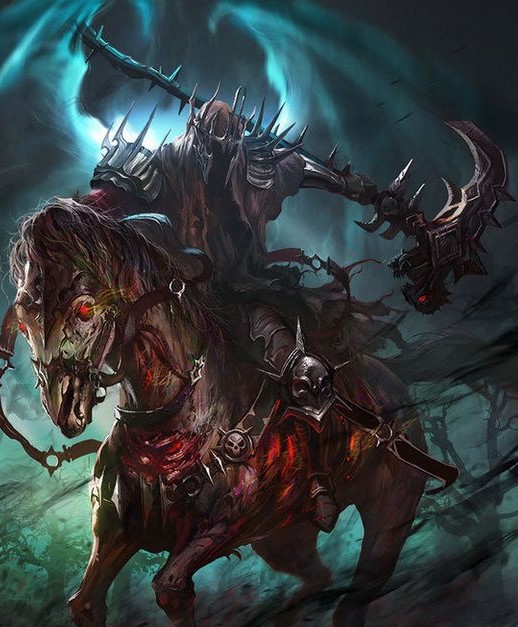
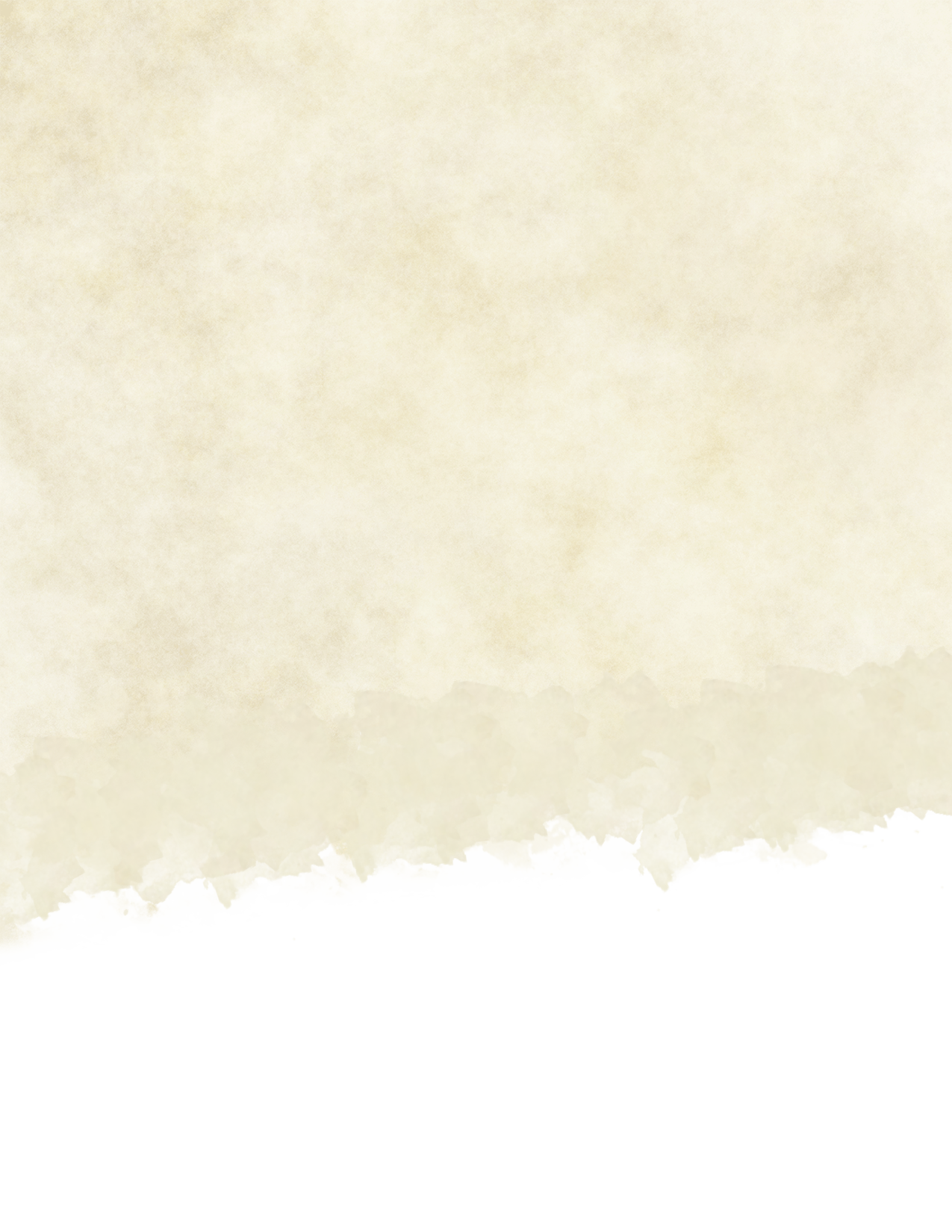
Death Knight
A red-skinned tiefling, heavily armored, menacing, rides his skeletal horse through a small village. With the vicious sword at his side and skull-emblazoned shield on his back, he may look like the villain here, and villagers instinctively shy back at his presence, but in truth, the mayor is overjoyed to see him. The tiefling is here to slay some monsters.
A fallen aasimar, trailed by an entourage of zombies, faces down her brigand foes. The bandits draw their swords and charge. She simply stands there, weaving her hands and
muttering. Her eyes light up with crackling energy. They brought swords to a magic fight.
A water genasi twists out of the way of an arrow, brandishing his twin swords. He needs to regroup with his allies, but they're far off, and he's pinned down by archers. He whistles, and a giant bat descends from the sky. He mounts his nocturnal steed and takes off toward reinforcements.
Death Knights are
The Death Knight
| Level | Proficiency Bonus | Features | Cantrips Known | 1st | 2nd | 3rd | 4th | 5th |
|---|---|---|---|---|---|---|---|---|
| 1st | +2 | Dark Sacrifice, Grim Reaping (1/rest), Spellcasting | 2 | — | — | — | — | — |
| 2nd | +2 | Fighting Style, Sinister Mount | 2 | 2 | — | — | — | — |
| 3rd | +2 | Deathly Paradigm | 2 | 2 | ─ | — | — | — |
| 4th | +2 | Ability Score Improvement | 2 | 3 | ─ | — | — | — |
| 5th | +3 | Extra Attack, Grim Reaping (2/rest) | 2 | 3 | 2 | — | — | — |
| 6th | +3 | Deathly Paradigm feature | 2 | 4 | 2 | — | — | — |
| 7th | +3 | New Reaping, Undying Will | 2 | 4 | 3 | — | — | — |
| 8th | +3 | Ability Score Improvement | 2 | 4 | 3 | — | — | — |
| 9th | +4 | Grim Reaping (3/rest) | 2 | 4 | 3 | 2 | — | — |
| 10th | +4 | Deathly Paradigm features, Sinister Mount improvement | 3 | 4 | 3 | 2 | — | — |
| 11th | +4 | Dark Sacrifice improvement, New Reaping | 3 | 4 | 3 | 3 | — | — |
| 12th | +4 | Ability Score Improvement | 3 | 4 | 3 | 3 | — | — |
| 13th | +5 | Fearless, Grim Reaping (4/rest) | 3 | 4 | 3 | 3 | 1 | — |
| 14th | +5 | Deathly Paradigm feature | 4 | 4 | 3 | 3 | 1 | — |
| 15th | +5 | Sadistic Solidarity | 4 | 4 | 3 | 3 | 2 | — |
| 16th | +5 | Ability Score Improvement | 4 | 4 | 3 | 3 | 2 | — |
| 17th | +6 | Grim Reaping (5/rest), New Reaping | 4 | 4 | 3 | 3 | 2 | 1 |
| 18th | +6 | Deathly Paradigm feature | 4 | 4 | 3 | 3 | 3 | 1 |
| 19th | +6 | Ability Score Improvement | 4 | 4 | 3 | 3 | 3 | 2 |
| 20th | +6 | Unquenchable Bloodlust | 4 | 4 | 3 | 3 | 3 | 2 |
fearsome warriors and wily spellcasters, combining their dark abilities with their martial training. They may be villainous necromancers hellbent on subjugating their foes, or outcast mercenaries trying to survive despite prejudice against them, or even great heroes lauded by their kingdom as they are feared by foreigners. Whatever the case may be, they bring a unique and macabre set of skills to any adventure.
Path of Shadows
Death knights are not inherently evil - though they may be - and yet they have chosen to follow a path in life that leads to dark powers and great violence. They may be outcasts who found a way to fit in with a death knight mentor, or perhaps vengeful warriors seeking to empower themselves to take their retribution, or maybe bystanders who stumbled upon their powers by mistake and got pulled into a world of monsters and killing, or maybe something else entirely. There are many reasons why one might embark on such a morbid lifestyle.
Grim Companions
Despite their ghastly inclinations, death knights make
excellent companions to adventurers looking for extra security or those seeking friends in low places. In fact,
companionship with the damned is part of what fuels their powers, and it is likely this link that leads them to adopt their sinister mounts.
Creating a Death Knight
As you create a death knight, there are a couple important things to consider. First, what is the nature of their powers? Were they granted by a powerful undead entity? Do they come from a spiritual bond with an unholy artifact? Did they undertake research and training into the skills of a death knight on their own, or were they perhaps trained by a master or guild? Next, it is important to consider what kind of lifestyle they lead, be it mercenary, assassin, vengeful warrior, or something else entirely.
Quick Build
You can create a death knight quickly by following these suggestions. First, make Strength your highest ability score, followed by Charisma, then Constitution. Second, choose the Haunted One background.
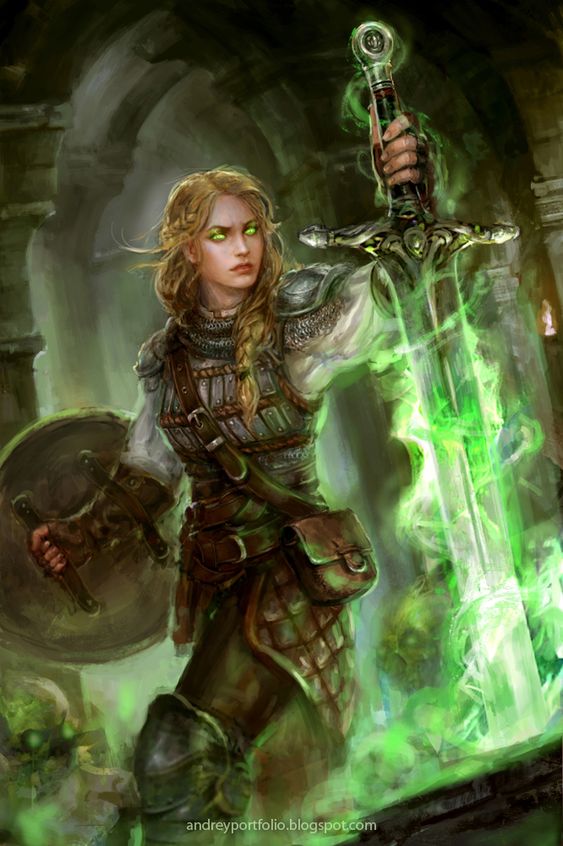
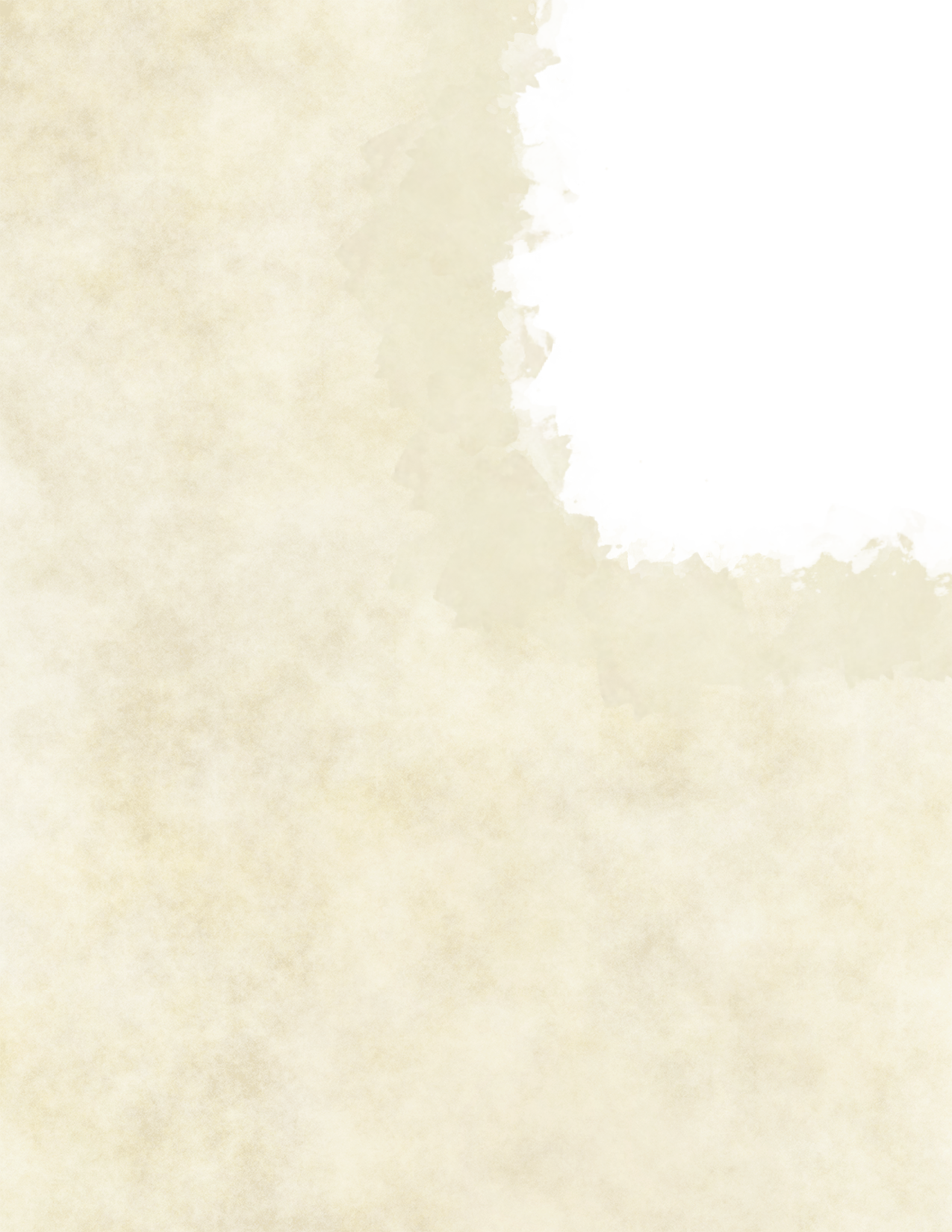
Class Features
As a death knight, you gain the following class features.
Hit Points
- Hit Dice: 1d10 per death knight level
- Hit Points at 1st Level: 10 + your Constitution modifier
- Hit Points at Higher Levels: 1d10 (or 6) + your Constitution modifier per death knight level after 1st
Proficiencies
- Armor: All armor, shields
- Weapons: Simple weapons, martial weapons
- Tools: None
- Saving Throws: Constitution, Charisma
- Skills: Choose three from Animal Handling, Arcana, Athletics, Deception, History, Insight, Intimidation, Medicine, Religion, Survival
Equipment
You start with the following equipment, in addition to the equipment granted by your background:
- (a) a martial weapon and a shield or (b) two martial weapons
- (a) a light crossbow and 20 bolts or (b) any simple weapon
-
- (a) chain mail or (b) scale mail
- (a) a dungeoneer's pack or (b) a burglar's pack
- An unholy artifact
Dark Sacrifice
Beginning at 1st level, as a bonus action, you may sacrifice hit points to deal additional damage on your next successful physical or magical attack. The extra damage is dealt as necrotic and is equal to half the hit points you sacrificed. On a single turn, you may sacrifice a number of hit points equal to your Constitution modifier + twice your Death Knight level (minimum of 1).
Starting at 11th level, you may add your Charisma modifier to the extra necrotic damage.
Grim Reaping
Beginning at 1st level, you are empowered by the death of your foes. Each time an enemy dies in combat within 150 feet of you - whether or not you were the one to kill them - you may use your reaction to reap their soul and augment your capabilities. When you use this feature, choose a Reaping to apply to yourself. You can use this feature a number of times as shown in the Death Knight table. You must finish a short or long rest to regain any expended uses.
At 1st level, you may learn one of the Reapings below. You may choose an additional Reaping to learn at 7th, 11th, and 17th levels. You will also learn a Reaping at 3rd level from your Deathly Paradigm.
Armor of Antipathy
When you use your Grim Reaping feature, your armor is enchanted with dark power, increasing your AC 2 until the end of your next turn. If an enemy attempts - and fails - to land on attack on you during that time, you may use your reaction to attack or cast a spell on them in return.
Dark Magic
When you use your Grim Reaping feature, you regain one expended spell slot of your choice. You may not regain a spell slot of a higher level than 5th with this feature.
Deadly Skill
When you use your Grim Reaping feature, you may double your proficiency bonus for one skill of your choice in which you are proficient for a number of hours equal to your Charisma modifier.
Immortal Soul
When you use your Grim Reaping feature, you gain advantage on all Intelligence, Wisdom, Charisma, and death saving throws for the next minute.
Malicious Mourning
When you use your Grim Reaping feature, choose one creature, who must make a Charisma saving throw (against your Spell Save DC) or immediately suffer half the damage that the creature that triggered the Reaping suffered just before death, using the same damage type(s). On a successful save, the creature instead suffers 1/4 the aforementioned damage.
Necrotic Empowerment
When you use your Grim Reaping feature, your next successful weapon attack within the next minute deals extra necrotic damage equal to 1d10 + half your Death Knight level (rounded down).
Regenerative Reaping
When you use your Grim Reaping feature, you instantly regain hit points equal to 1d8 + half your Death Knight level (rounded down).
Unholy Harvest
When you use your Grim Reaping feature, you have advantage on attack rolls with necromancy spells for the next minute.
Wings of Death
When you use your Grim Reaping feature, you sprout wings of darkness from your back and gain a fly speed of 60 feet for the next minute.
Spellcasting
You have developed a connection to the darker forces of magic through a combination of sheer willpower and unholy dedication to your martial path.
Cantrips
At 1st level, you know two cantrips of your choice from the death knight spell list. At higher levels, you learn additional death knight cantrips of your choice, as shown in the Cantrips Known column of the Death Knight table.
Preparing and Casting Spells
Once you have reached 2nd level, you may cast spells of a higher level than cantrips.
The Death Knight table shows how many spell slots you have to cast your death knight spells. To cast one of your death knight spells of 1st level or higher, you must expend a slot of the spell's level or higher. You regain all expended spell slots when you finish a long rest.
You prepare the list of death knight spells that are available for you to cast, choosing from the death knight spell list. When you do so, choose a number of death knight spells equal to your Charisma modifier + half your death knight level, rounded down (minimum of one spell). The spells must be of a level for which you have spell slots.
You can change your list of prepared spells when you finish a long rest. Preparing a new list of death knight spells requires time spent meditating on mortality: at least 1 minute per spell level for each spell on your list.
Spellcasting Ability
Charisma is your spellcasting ability for your death knight spells since your magical power derives from your will against and with death. You use your Charisma whenever a death knight spell refers to your spellcasting ability. In addition, you use your Charisma modifier when setting the saving throw DC for a death knight spell you cast and when making an attack roll with one.
Spell Save DC
Spell attack modifier
Spellcasting Focus
You can use an unholy artifact as a spellcasting focus for your death knight spells. Some examples of unholy artifacts include a ring containing the souls of the damned, the skull of a long-dead necromancer, a desecrated holy symbol, or an amulet cursed to infect all but its rightful owner with
disease when worn.
Fighting Style
Starting at 2nd level, you adopt a particular style of fighting as your specialty. Choose one of the following options. You can't take a Fighting Style option more than once, even if you later get to choose again.
Archery
You gain a +2 bonus to attack rolls you make with ranged weapons.
Blind Fighting
You have blindsight with a range of 10 feet. Within that range, you can effectively see anything that isn't behind total cover, even if you're blinded or in darkness. Moreover, you can see an invisible creature within that range, unless the creature successfully hides from you.
Defense
While you are wearing armor, you gain a +1 bonus to AC.
Dueling
When you are wielding a melee weapon in one hand and no other weapons, you gain a +2 bonus to damage rolls with that weapon.
Great Weapon Fighting
When you roll a 1 or 2 on a damage die for an attack you make with a melee weapon that you are wielding with two hands, you can reroll the die and must use the new roll, even if the new roll is a 1 or a 2. The weapon must have the two-handed or versatile property for you to gain this benefit.
Interception
When a creature you can see hits a target, other than you, within 5 feet of you with an attack, you can use your reaction to reduce the damage the target takes by 1d10 + your proficiency bonus (to a minimum of 0 damage). You must be wielding a shield or a simple or martial weapon to use this reaction.
Protection
When a creature you can see attacks a target other than you that is within 5 feet of you, you can use your reaction to impose disadvantage on the attack roll. You must be wielding a shield.
Thrown Weapon Fighting
You can draw a weapon that has the thrown property as part of the attack you make with the weapon.
In addition, when you hit with a ranged attack using a thrown weapon, you gain a +2 bonus to the damage roll.
Two-Weapon Fighting
When you engage in two-weapon fighting, you can add your ability modifier to the damage of the second attack.
Sinister Mount
Starting at 2nd level, embolded by your dark crusade, you may acquire a mount that you develop a dark magical bond with. You may choose a mount that is a beast with a challenge
rating of 1 or less that is at least once size larger than you (and is not a swarm), or any creature from the following list that is at least one size larger than you: amphisbaena, ashen warhorse, bone whelk, death dog, female steeder, giant strider, hippogriff, male steeder, rust monster, skeletal riding horse, stench kow, thorny vegepygmy, or warhorse skeleton. At your DM's discretion, you may choose another aberration, fiend, monstrosity, undead, or other creature provided the creature is at least one size larger than you and has a challenge rating no greater than 1.
Once bonded, the mount's hit points increase by 1d8 (or 5) + your Charisma modifier. Additionally, dark magic influences the mount, and if it did not have one before, it now takes on a more sinister appearance and gains resistance to necrotic damage. Each time you gain a death knight level, your sinister mount's total hit points increase by 1.
While mounted, you have advantage on Charisma (Intimidation) checks against creatures that are smaller than your mount.
If your mount dies, you must wait at least 48 hours before bonding a new mount. When reduced to 0 hit points, if your sinister mount does not die outright from the damage or another effect, it falls unconscious, and must start making death saving throws like a player character.
Your sinister mount gains additional features based on your Deathly Paradigm at 10th level.
Deathly Paradigm
When you reach 3rd level, you focus your death knight training on a specific deathly subject. Your martial and magical prowess develops in a unique way based on this choice. Choose a Deathly Paradigm from the list at the end of the class description. You gain features when you choose a Deathly Paradigm at 3rd level, and again at 6th, 10th, 14th, and 18th levels.
Paradigm Spells
Each Deathly Paradigm has a list of associated spells. You gain access to these spells at the levels specified in the paradigm description. Once you gain access to a paradigm spell, you always have it prepared. Paradigm spells don't count against the number of spells you can prepare each day. At 3rd level, your Paradigm will also grant you access to a cantrip. This counts as a death knight cantrip for you, but does not count toward your number of cantrips known.
If you gain a paradigm spell that doesn't appear on the death knight spell list, the spell is nonetheless a death knight spell for you.
Extra Attack
Beginning at 5th level, you can attack twice, instead of once, whenever you take the Attack action on your turn.
Undying Will
Starting at 7th level, you may use your reaction to add your Charisma modifier to an ability check or saving throw you have to make. You can use this feature a number of times equal to your proficiency bonus. If the roll already applies your Charisma modifier, you simply add it again. You regain any expended uses after finishing a long rest.
Fearless
At 13th level, you become immune to being frightened.
Sadistic Solidarity
Starting at 15th level, when an ally within 30 feet of you takes damage from a critical hit and/or damage that reduces them to 0 hit points, you have advantage on the next ability check, attack roll, or saving throw you make within the next minute.
Unquenchable Bloodlust
Starting when you reach 20th level, any time you kill an enemy, you may move up to half your speed and make an additional attack or cast an additional cantrip as a reaction.
Deathly Paradigms
The following section contains a guide to all of the Deathly Paradigm options and the features they grant.
Abyssal Knight
Death knights of this paradigm have a strong connection to this abyss. It could be a religious one, if they worship a demon lord, or one of convenience, as they have found a way to empower themselves by channelling the abyss. Or it could be neither of these. Regardless, their powers grow over time to rival that of great demons.
Abyssal Lexicon
When you choose this Deathly Paradigm at 3rd level, you learn to speak, read, and write Abyssal.
Grim Reaping: Magical Protection
You learn this Reaping option when you choose this Deathly Paradigm at 3rd level.
When you use your Grim Reaping feature, you become resistant to magical damage for the next minute.
Abyssal Knight Spells
| Death Knight Level | Spells |
|---|---|
| 3rd | acid splash, detect magic, entangle |
| 5th | darkness, detect thoughts |
| 9th | fly, summon lesser demons |
| 13th | confusion, summon greater demon |
| 17th | dominate person, immolation |
Layer Link
When you reach 6th level in this class, you develop an arcane link with one of the layers of the Abyss. Choose one of the layers from the table below, gaining its features. This choice also determines the features you gain at 18th level.
When you reach 14th level, you develop a second link. Choose another layer from the table, gaining its features. This choice also determines the features you gain at 18th level.
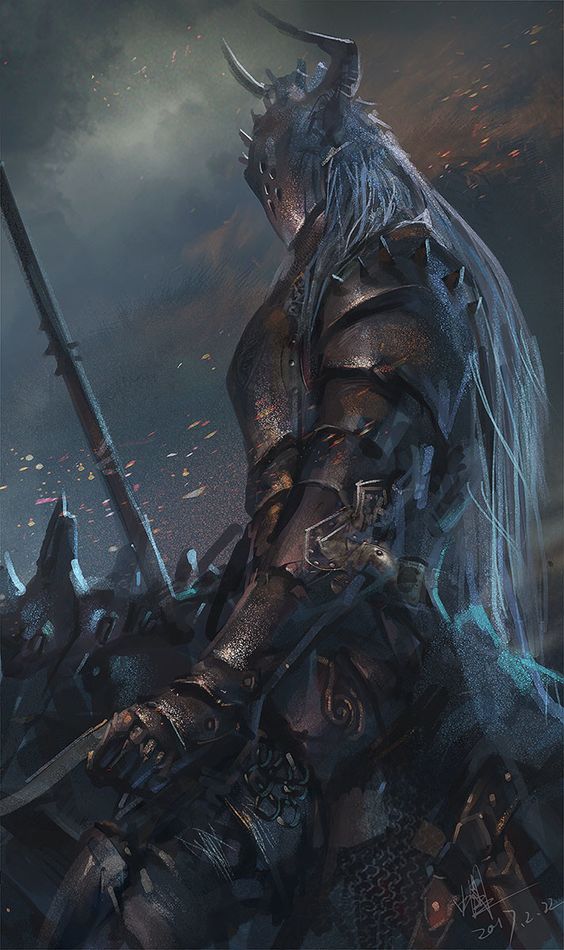

| Layer | Feature |
|---|---|
| The Gaping Maw | Fearsome Critical. When you score a critical hit against an enemy, the target must succeed on a Charisma saving throw (against your spell save DC) or become frightened of you until the start of your next turn. |
| Thanatos | Undead Vigor. When you are reduced to 0 hit points but not killed outright, you instead drop to a number of hit points equal to your proficiency bonus. Once triggered, you can't use this feature again until you finish a long rest. |
| The Demonweb | Web Walker. You ignore movement restrictions caused by webbing, and can cast spider climb at will, without expending a spell slot. |
| The Endless Maze | Maze Runner. You become proficient with two of the following skills or tools of your choice: Athletics, Survival, cartographer's tools, or navigator's tools. |
| The Triple Realm | Tricky Haggler. You have advantage on Charisma (Deception), Charisma (Persuasion), and Wisdom (Insight) checks you make regarding the trade of goods and services. |
| Death Dells | Snare Strength. You have advantage on Strength (Athletics) checks made to grapple creatures and to escape grapples. |
Abyssal Corruption
At 10th level, you gain the ability to use this feature. As an action, you channel the corrupting influence of the Abyssal Plane and direct it to a creature of your choice. The creature must make a Charisma saving throw (against your spell Save DC) or become corrupted for the next minute. Roll a d10 on the table below to determine the effects of this corruption. A creature can repeat the saving throw at the end of each of its turns, ending the effect on itself on a success.
| d10 | Result |
|---|---|
| 1-4 | Treachery. The creature turns on their allies, focusing their turns on defeating any creatures allied with or friendly to them. |
| 5-7 | Bloodlust. The creature has an insatiable need for violence. The creature cannot willingly leave the range of its enemies, and on its turns it can do nothing other than to move into range and attack its enemies, even at its own risk. |
| 8-9 | Mad Ambition. The creature becomes insane with ambitions of rulership. On its turns, it can do nothing except issue commands and suggestions to its allies, whether or not its allies will actually listen to it. |
| 10 | Demonic Posession. The creature is possessed by a demonic entity until freed by dispel good and evil or similar magic. Unlike other results, the creature does not have the opportunity to end this effect via a saving throw at the end of their turn. Whenever the possessed creature rolls a 1 on an attack roll, ability check, or saving throw, the demon takes control of |
| d10 | Result |
|---|---|
| 10 (cont.) | the creature and determines the creature's behavior. At the end of each of the possessed creature's turns, it can make a Charisma saving throw. On a success, the creature regains control until he or she rolls another 1. |
You can use this feature a number of times equal to half your proficiency bonus (rounded down), regaining any expended uses after finishing a long rest.
Demonic Mount
When you reach 10th level, your sinister mount becomes demonic both in appearance and power. It gains the following features:
Fiend Type. Your sinister mount's creature type changes to fiend if it wasn't already.
Spider Climb. Your sinister mount can move up, down, and across vertical surfaces - including upside along ceilings - using its walk speed. It can do this with a rider, and the rider has no difficulty maintaining their grip.
Blindsight. Your sinister mount gains 30 feet of blindsight (if it already had blindsight, it gains an additional 30 feet).
Teleport. As a bonus action, your sinister mount can teleport up to 120 feet to an unoccupied space it can see. It can use this feature a number of times equal to its Constitution or Charisma modifier (whichever is higher; minimum of once), regaining any expended uses after finishing a long rest.
Abyssal Ascendance
When you reach 18th level, you gain two of the features detailed in the table below based on the Layer Links you choose at 6th and 14th levels.
| Layer | Feature |
|---|---|
| The Gaping Maw | Terrain of the Maw. While in coastal, forest, swamp, or underwater terrain, your movement speed (and that of your sinister mount) increases by 15 feet. |
| Thanatos | Necromantic Surge. You may cast one necromancy spell of 4th level or lower that you have prepared without expending a spell slot. When casting a spell of a lower level, you can choose to cast it at 4th level with this feature. You can do this once, and must finish a long rest before you can use this feature again. |
| The Demonweb | Spells of Lolth. You may cast pass without trace and web once per long rest each without expending a spell slot or having the spells prepared. |
| The Endless Maze | Maddening Disorientation. You may cast the confusion spell once per long rest without expending a spell slot or having the spell prepared. |
| The Triple Realm | Triple Resilience. You become immune to being blinded and deafened, and you gain resistance to cold damage. |
| Layer | Feature |
|---|---|
| Death Dells | Summon Gnolls. Once per long rest, you may summon four gnoll slaves from the Death Dells as an action. Roll initiative for the gnolls as a group, which has its own turns. The gnolls remain for 1 hour or until slain or dismissed as a bonus action action. A gnoll summoned by this feature disappears when it drops to 0 hit points or the effect ends. While you maintain concentration, the gnolls act under your command (no action required by you) and are friendly to you and your companions. If you don't issue any commands to them, they defend themselves from hostile creatures, but otherwise take no actions. If your concentration is broken, the gnolls are freed and may become hostile. The gnoll stat block can be found in the Monster Manual. |
Blood Knight
All death knights pursue a path of violence and bloodshed, and those who follow this paradigm have embraced this fully. They find power in their own blood and the blood of their enemies, and can be just as helpful an ally as they can be a terrifying enemy.
Physician's Proficiency
Wheen you choose this Deathly Paradigm at 3rd level, you become proficient in either the Medicine skill or with herbalism kits (your choice).
Grim Reaping: Baleful Bloodshed
You learn this Reaping option when you choose this Deathly Paradigm at 3rd level.
When you use your Grim Reaping feature, your weapons are empowered to make your enemies bleed. Within the next minute, after your first successful weapon attack on an enemy each turn, they are left bleeding profusely, and will take necrotic damage equal to half the damage dealt at the start of their next turn. This does not work on constructs or undead.
Blood Knight Spells
| Death Knight Level | Spells |
|---|---|
| 3rd | thorn whip, cure wounds, inflict wounds |
| 5th | cloud of daggers, hold person |
| 9th | life transference, vampiric touch |
| 13th | locate creature, toxify blood* |
| 17th | freeze blood*, mass cure wounds |
Regenerative Blood
Starting at 6th level, whenever you expend hit dice to regain hit points, you regain additional hit points equal to your Charisma modifier. Additionally, once per long rest, you may choose to expend hit dice when you are healed by a spell to receive additional healing. The number of hit dice you can expend in this manner is equal to one fourth of your Death Knight level, rounded down (minimum of one).
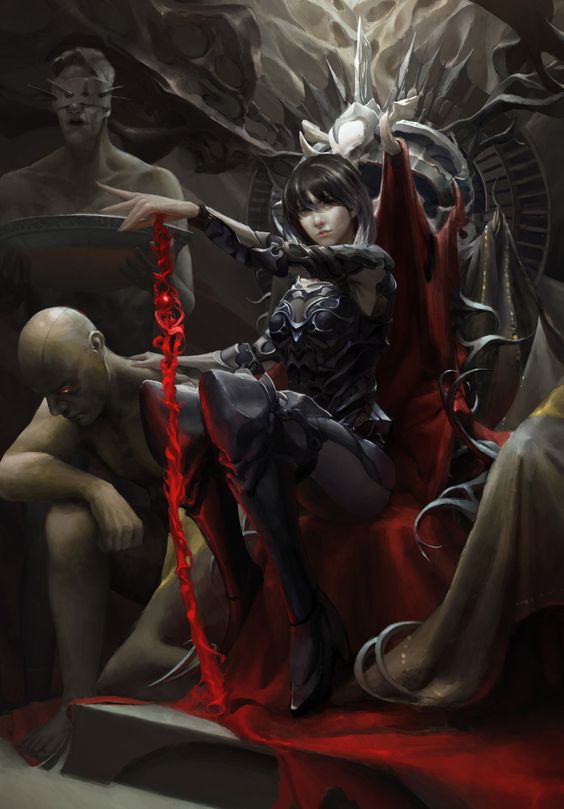

Blood for Blood
Beginning at 10th level, the damage dealt by your Dark Sacrifice feature is equal to the amount of hit points you sacrificed + your proficiency bonus.
Vampiric Mount
When you reach 10th level, your sinister mount becomes vampiric in both appearance and power. It gains the following features:
Undead Type. Your sinister mount's creature type changes to undead if it wasn't already.
Spider Climb. Your sinister mount can move up, down, and across vertical surfaces - including upside along ceilings - using its walk speed. It can do this with a rider, and the rider has no difficulty maintaining their grip.
Darkly Charming. Your sinister mount's Charisma score increases by 2, and you have advantage on Charisma (Persuasion) checks while mounted (except against creatures immune to being charmed).
Drain Life. After a successful melee attack, your sinister mount regains hit points equal to half the damage dealt.
Siphon Health
When you reach 14th level, you may use your bonus action to siphon health from your enemy. Whenever you deal damage to an enemy with an attack or a spell, if you are within 5 feet of them, you may use this feature to attempt to absorb hit points. The target must succeed on a Constitution saving throw (against your spell save DC), or you regain hit points equal to half of the damage dealt (rounded down).
Blood Form
At 18th level, you gain the ability to use this feature. As an action, you may take on a form of pure blood for up to 1 minute. While in this form, you can take no damage, your movement speed increases by 5 feet, you regain a number of hit points equal to your Charisma modifier at the end of each turn, you cannot attack or cast spells, you may not ride your sinister mount, you can pass through spaces as narrow as one inch wide without squeezing, and you can pass through enemy spaces or any porous objects as if they were difficult terrain.
If you pass through a creature's space while in this form, they must make a Constitution saving throw (against your spell save DC), taking 2d4 necrotic damage on a failed save, or half as much on a successful one. Friendly creatures are subject to the same damage as enemies should you pass through their space. You may dismiss this form at will as a bonus action.
You may use this feature a number of times equal to half your proficiency bonus (rounded down). You regain any expended uses after finishing a long rest.
Corvus Knight
Ravens, crows, and other corvids are closely associated with death in many cultures. Some deities, such as The Raven Queen, draw rather directly on this symbolism. Death knights of this paradigm may follow one such deity, or simply find empowerment in the darkly fey magic associated with corvids.
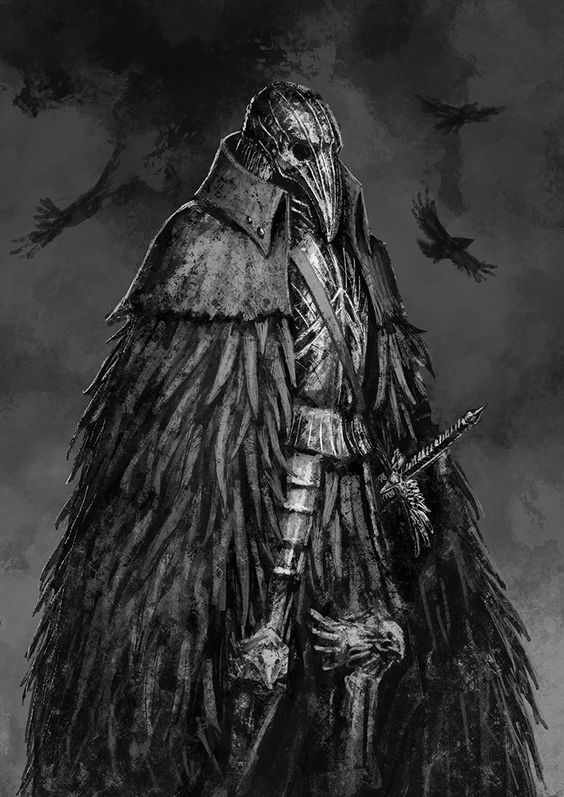

Avian Proficiency
When you choose this Deathly Paradigm at 3rd level, you become proficient in either the Perception or Survival skill (your choice).
Grim Reaping: Carrion Flight
You learn this Reaping option when you choose this Deathly Paradigm at 3rd level.
When you use your Grim Reaping feature, crowlike wings sprout from your back and you gain a fly speed of 35 feet for the next minute. When you hit enemies with an attack for this duration, they must succeed on a Constitution saving throw (against your spell save DC) or be poisoned until the end of their next turn.
Corvus Knight Spells
| Death Knight Level | Spells |
|---|---|
| 3rd | gust, feather fall, zephyr strike |
| 5th | augury, gust of wind |
| 9th | fear, fly |
| 13th | arcane eye, freedom of movement |
| 17th | control winds, hallow |
Harbinger Raven
At 6th level, you gain the ability to summon a dark, spectral raven to bolster your capabilities and harass your foes. As a bonus action, you can summon a harbinger raven in an unoccupied space within 15 feet of you. The raven remains for up to 1 hour, or until you dismiss it as a bonus action. You can use this feature once, and regain the ability to do so upon finishing a long rest.
While the raven is alive, you can cast fortune's favor and
bane at 2nd level once each without expending a spell slot or requiring verbal or material components. When you cast these spells in this way, you can cast them from yourself or from the raven.
The raven's statistics are detailed below. Roll initiative for the raven. If not otherwise commanded, on its turn, it will follow you and stay within 15 feet of you to the best of its ability, avoiding provoking opportunity attacks. It will take no other actions than the Dodge action, though it may use its bonus action to Disengage when applicable. It will also use its reaction to make opportunity attacks should the occasion arise. You can use your bonus action to issue a command to the raven, at which point you can take full control of it on its next turn.
Harbinger Raven
Tiny fey, shares your alignment
- Armor Class 12
- Hit Points 1d4 + your Charisma modifier
- Temporary Hit Points 1 + your Death Knight level
- Speed 10 ft., fly 50 ft.
STR DEX CON INT WIS CHA 2 (-4) 14 (+2) 8 (-1) 2 (-4) 14 (+2) 8 (-1)
- Saving Throws Wisdom +5, Charisma +2
- Skills Perception +5, Stealth +5
- Damage Resistances Necrotic, Psychic; Bludgeoning, Piercing, and Slashing from Nonmagical Attacks
- Condition Immunities Charmed, Exhaustion, Grappled, Frightened, Paralyzed, Petrified, Stunned
- Senses Darkvision 60 ft., passive Perception 15
- Languages Understands one language you know, but cannot speak
Mimicry. The raven can mimic simple sounds it has heard, such as a person whispering, a baby crying, or an animal chittering. A creature that hears the sounds can tell they are imitations with a successful DC 13 Wisdom (Insight) check.
Avian Deftness. The raven can take the Disengage or Hide action as a bonus action.
Actions
Demoralizing Beak. Melee Weapon Attack: +5 to hit, reach 5 ft., one target. Hit: 1d2+2 piercing damage + 1d2 psychic damage. The target must succeed on a DC 13 Wisdom saving throw or have disadvantage on the next attack roll, ability check, or saving throw it makes.
Shadow Talons. Melee Weapon Attack: +5 to hit, reach 5 ft., one target. Hit: 1d4+2 slashing damage +1d6 necrotic damage.
Corvid Swarm
At 10th level, your magic is imbued with corvid power. When you expend a spell slot to cast one of your Corvid Knight spells, you may instantaneously summon a swarm of ravens, crows, magpies, rooks, or jackdaws (in any case, use the statistics for the swarm of ravens) in an unoccupied space within 10 feet of the spell's target. The swarm remains for one hour (no concentration required by you), until it dies, or until you dismiss it as a bonus action. The swarm shares your initiative count and takes its turn immediately following you. You control the swarm (no action required by you). You may have multiple swarms summoned at once in this manner, up to a maximum number equal to half your proficiency bonus (rounded down).
Fowl Mount
When you reach 10th level, your sinister mount becomes darkly birdlike in both appearance and power. It gains the following features:
Corvid Type. Your sinister mount's creature type changes to one of the following of your choice (or can remain, if it is already one of the following): beast, fey, fiend, or monstrosity.
Corvus Wings. Your sinister mount grows corvid-like wings, gaining a fly speed of 50 feet. If your sinister mount already had a flying speed equal to or greater than 50 feet, it increases by 10 feet. Similarly, if it already had wings, its wings take on a more corvid appearance.
Mimicry. Your sinister mount can mimic simple sounds it has heard, such as a person whispering, a baby crying, or an animal chittering. A creature that hears the sounds can tell they are imitations with a successful Wisdom (Insight) check, the DC of which is equal to 8 + your sinister mount's Constitution modifier + its proficiency bonus.
Carrier Resilience. Your sinister mount is immune to disease and has advantage on saving throws against being poisoned.
Arcane Emissary
At 14th level, you learn the cantrip message and it does not count toward your total number of cantrips known. Additionally, the spells illusory script, magic mouth, skywrite, sending, and galder's speedy courier are added to the Death Knight spell list for you. Once per long rest, you may cast one of these spells - provided you have it prepared - without expending a spell slot.
Shade Hover
When you reach 18th level, shadowy power lifts you off the ground, allowing you to hover at all times. You become immune to being knocked prone, you are unaffected by difficult terrain, and you may safely move across dangerous surfaces such as lava or quicksand. While mounted, you confer this trait upon your sinister mount. If you are incapacitated, you cease to hover and can no longer confer this trait upon your mount.
Deep Knight
Having attained aberrant power, death knights of this paradigm resemble aberrations and embody the strange powers from the far realm. They develop otherworldly magic and psychic abilities that complement their martial training.
Deep Lexicon
When you choose this Deathly Paradigm at 3rd level, you learn to speak, read, and write Deep Speech.
Grim Reaping: Visions of the Beyond
You learn this Reaping option when you choose this Deathly Paradigm at 3rd level.
When you use your Grim Reaping feature, you gain 60 feet of truesight for the 10 minutes.
Deep Knight Spells
| Death Knight Level | Spells |
|---|---|
| 3rd | mind sliver, arms of hadar, magnify gravity |
| 5th | crown of madness, detect thoughts |
| 9th | hunger of hadar, intellect fortress |
| 13th | evard's black tentacles, summon aberration |
| 17th | synaptic static, telekinesis |
Telepathic Speech
Starting at 6th level, you can form a telepathic connection between your mind and the mind of another. As a bonus action, choose one creature you can see within 30 feet of you. You and the chosen creature can speak telepathically with each other while the two of you are within a number of miles of each other equal to your Charisma modifier (minimum of 1 mile). To understand each other, you each must speak mentally in a language the other knows.
The telepathic connection lasts for a number of minutes equal to your death knight level. It ends early if you are incapacitated or die or if you use this ability to form a connection with a different creature.
Eye Rays
When you reach 10th level, your aberrant nature has advanced to the point that you can emit eye rays like the fabled beholders. As an action, you may shoot two of the following eye rays at random (re-roll duplicates), choosing one target for each ray (both rays can target the same creature) within 120 feet of you. When a ray calls for a saving throw, the save DC is your spell save DC.
| d12 / Eye Ray | Description |
|---|---|
| 1. Aversion Ray | The target must make a Charisma saving throw. On a failed save, the target has disadvantage on attack rolls for 1 minute. The target can repeat the saving throw at the end of each of its turns, ending the effect on itself on a success. |
| 2. Charm Ray | The target must succeed on a Wisdom saving throw or be charmed by you for 1 minute. The target is friendly to you and your companions for the duration. The target can repeat the saving throw at the end of each of its turns, ending the effect on itself on a success. |
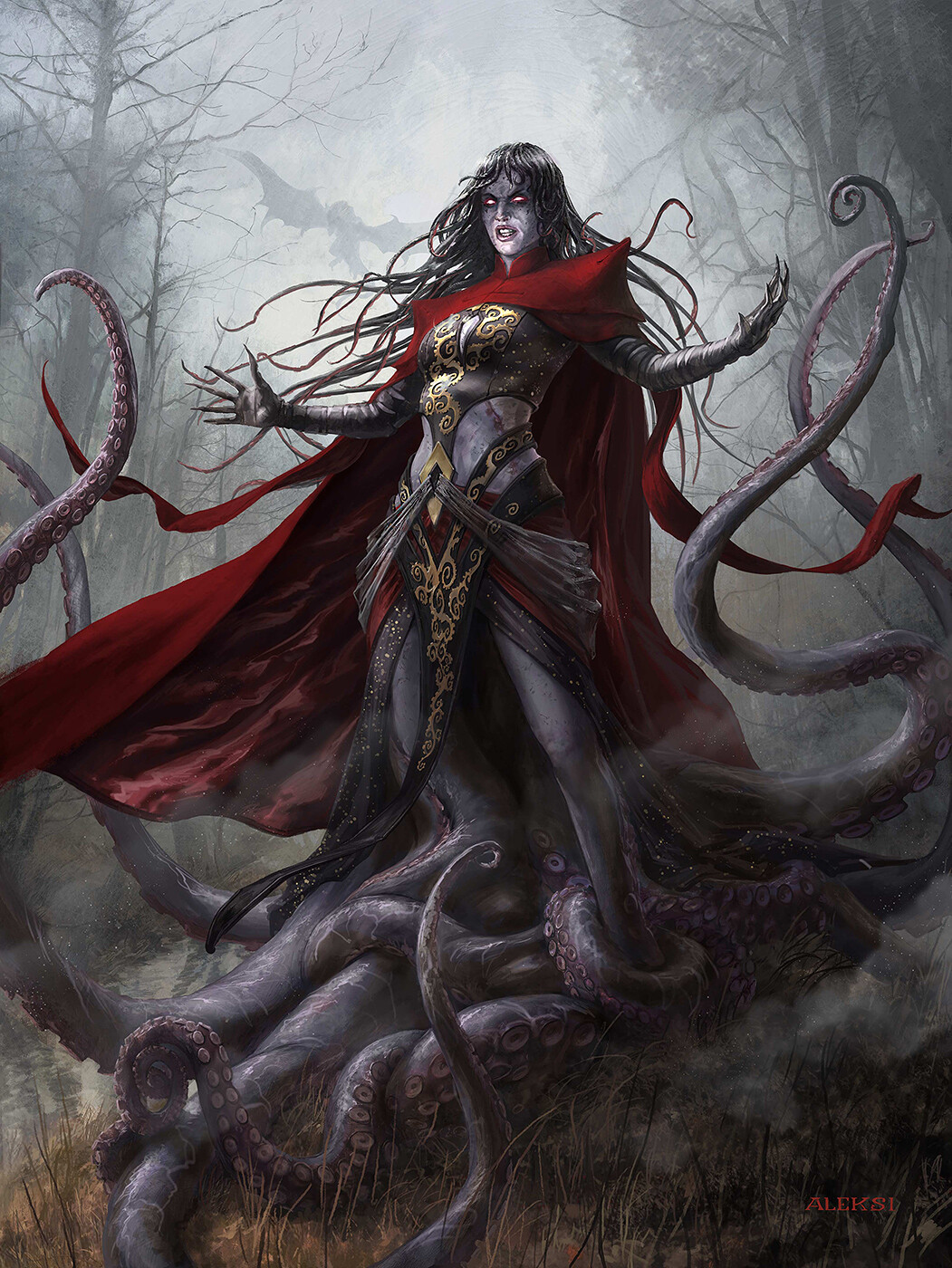

| d12 / Eye Ray | Description |
|---|---|
| 3. Fear Ray | The target must succeed on a Wisdom saving throw or be frightened of you for 1 minute. The target can repeat the saving throw at the end of each of its turns, ending the effect on itself on a success. |
| 4. Slowing Ray | The target must succeed on a Dexterity saving throw. On a failed save, for the next minute the target's speed is halved, the target can't take reactions, and it can take either an action or a bonus action on its turn, not both. The target can repeat the saving throw at the end of each of its turns, ending the effect on itself on a success. |
| 5. Stunning Ray | The target must succeed on a Constitution saving throw or be stunned for 1 minute. The target can repeat the saving throw at the start of each of its turns, ending the effect on itself on a success. |
| 6. Sleep Ray | The target must succeed on Wisdom saving throw or fall asleep and remain unconscious for 1 minute. The target awakens if it takes damage or another creature takes an action to wake it. This ray has no effect on constructs and undead. |
| 7. Telekinetic Ray | If the target is a creature, it must make a Strength saving throw. On a failed save, you move it up to 30 feet in any direction, and it is restrained by the ray's telekinetic grip until the start of your next turn or until you are incapacitated. If the target is an object weighing 300 pounds or less that isn't being worn or carried, it is telekinetically moved up to 30 feet in any direction. You can also exert fine control on objects with this ray, such as manipulating a simple tool or opening a door or a container. |
| 8. Psychic Ray | The target must succeed on an Intelligence saving throw or take 8d6 psychic damage, taking half damage on a successful save. |
| 9. Frost Ray | The target must succeed on a Dexterity saving throw or take 8d6 cold damage, taking half damage on a successful save. |
| 10. Fire Ray | The target must succeed on a Dexterity saving throw or take 8d6 fire damage, taking half damage on a successful save. |
| 11. Enervation Ray | The target must succeed on a Constitution saving throw or take 8d6 necrotic damage, taking half damage on a successful save. |
| 12. Disintegration Ray | If the target is a creature, it must succeed on a Dexterity saving throw or take 10d6 force damage, taking half damage on a successful save. If this damage reduces the target to 0 hit points, its body becomes a pile of fine grey dust. If the target is a Large or smaller nonmagical object or |
| d12 / Eye Ray | Description |
|---|---|
| 12. Disintegration Ray (cont.) | creation of magical force, it is disintegrated without a saving throw. If the target is a Huge or larger object or creation of magical force, this ray disintegrates a 10-foot cube of it. |
You may use this feature a number of times equal to half your proficiency bonus (rounded down). You regain expended uses after finishing a long rest.
Aberrant Mount
When you reach 10th level, your sinister mount becomes aberrant in both appearance and power. It gains the following features:
Aberration Type. Your sinister mount's creature type changes to aberration if it wasn't already.
Amphibious. Your sinister mount can breathe both air and water.
Telepathy. Your sinister mount gains 30 feet of telepathy. It can communicate with you telepathically out to a range of 300 feet.
Tentacles. Your creature companion has grown several tentacles. With its tentacles, it can make a Strength-based attack. The attack deals 1d8 + its Strength modifier in bludgeoning damage and the target creature is grappled. While grappled, the target creature is poisoned and restrained. As an action, your mount can constrict its tentacles on a grappled creature and secrete poison, dealing 1d6 bludgeoning damage and 1d4 + its Constitution modifier poison damage. A grappled creature can attempt to escape the grapple as an action on each of its turns, ending both the restrained and poisoned conditions on itself on a success.
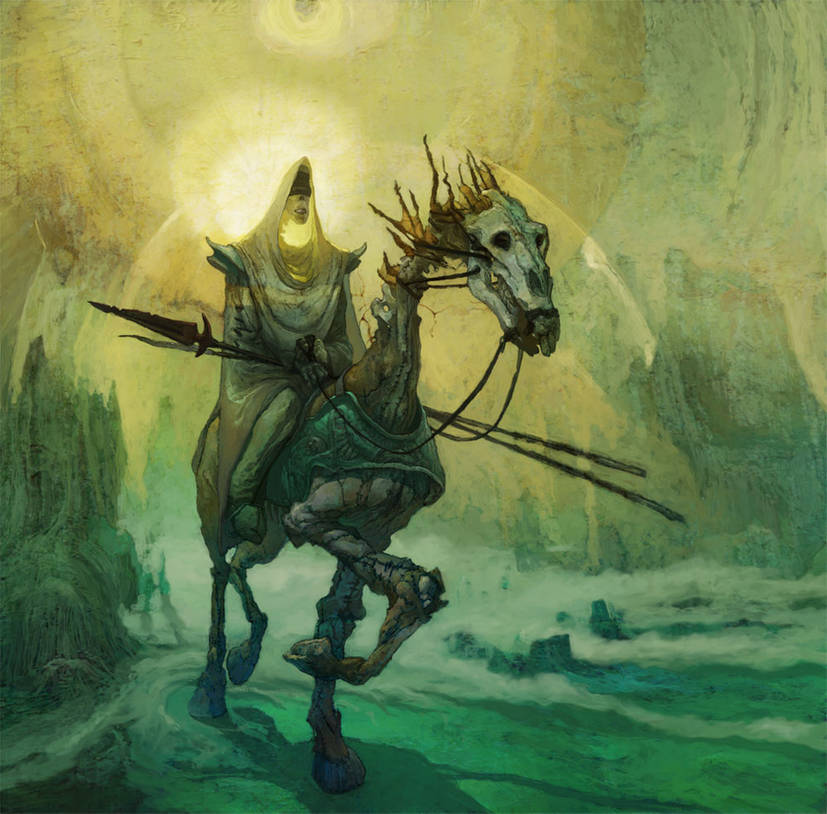

Psychic Fortitude
Starting at 14th level, you gain resistance to psychic damage, and you have advantage on saving throws against being charmed. Additionally, you are shielded from uninvited divination magic unless the creature attempting to use said divination magic also succeeds on an Intelligence saving throw (against your spell save DC).
Spell Reflection
Beginning at 18th level, if you make a successful saving throw against a spell, or a spell attack misses you, you can use your reaction to reflect the spell. Choose another creature (including the spellcaster) that you can see within 30 feet of you. The spell targets the chosen creature instead of you. If the spell forced a saving throw, the chosen creature makes its own save. If the spell was an attack, the attack roll is rerolled against the chosen creature.
You can use this reaction a number of times equal to half your Charisma modifier (rounded up), and regain any expended uses upon finishing a long rest.
Dread Knight
Because of their macabre nature, many people fear death knights. Those of this paradigm lean into the fear, weakening their foes with nightmarish magic and pure terror.
Unafraid
When you choose this Deathly Paradigm at 3rd level, you have advantage on saving throws against being frightened.
At 13th level, when you gain the Fearless feature, allies within 10 feet of you have advantage on saving throws against being frightened.
Grim Reaping: Crippling Terror
You learn this Reaping option when you choose this Deathly Paradigm at 3rd level.
When you use your Grim Reaping feature, your fear-causing spells are empowered to be immobilizing in their
horror. Within the next minute, the next spell you cast that causes any creatures to be frightened causes them to be stunned as well. The duration and saving throws for the spell remain the same.
Dread Knight Spells
| Death Knight Level | Spells |
|---|---|
| 3rd | thaumaturgy, cause fear, dissonant whispers |
| 5th | blindness/deafness, phantasmal force |
| 9th | enemies abound, fear |
| 13th | hallucinatory terrain, phantasmal killer |
| 17th | animate objects, dream |
Fear the Reaper
Starting at 6th level, any time you use your Grim Reaping feature, all foes that can see you must make a Wisdom saving throw (against your spell save DC) or be frightened until the start of your next turn.
Nightmare State
When you reach 10th level, you can tap into the collective fears of those around you to enter a nightmare state. As an action, you take on a nightmarish appearance for the next minute, gaining the following traits when you do so:
- You have advantage on Charisma (Intimidation) checks.
- Your AC increases by 1.
- You are resistant to psychic and necrotic damage.
- You cannot fall unconscious unless you are reduced to 0 hit points.
- Your attacks and damaging spells deal an extra 1d4 psychic damage.
- As a bonus action, you and one willing creature (including your mount) can teleport up to 30 feet to an unoccupied space you can see.
- Enemies have disadvantage on saving throws against any of your spells or features that cause the frightened condition.
You may use this feature once and regain the ability to do so upon finishing a long rest.
Starting at 18th level, you may use this feature twice per long rest, and the extra psychic damage increases to 2d4.
Nightmarish Mount
When you reach 10th level, your sinister mount becomes nightmarish in both appearance and power. It gains the following features:
Frightful Type. Your sinister mount's creature type changes to one of the following of your choice (or can remain, if it is already one of the following): fey, fiend, monstrosity, or undead.
Fearless. Your sinister mount is immune to being frightened.
Horrifying Aura. Any unfriendly creatures that begin their turn with 5 feet of your sinister mount must make a Wisdom saving throw (Save DC = 10 + your sinister mount's Constitution modifier + its Charisma modifier) or be frightened until the start of your next turn.
Astral Traveler. Once per long rest, as a bonus action, your sinister mount and up to three willing creatures within 5 feet of it (a rider does not count against this total) can enter the astral plane, or vise versa. This is a one way trip, and your mount cannot use this feature again until it completes a long rest.
Starting at 18th level, your sinister mount can select up to seven willing creatures within 15 feet of it (a rider still doesn't count against this total), and it can use this feature twice per long rest.
Unsleeping
Starting at 14th level, fueled by the power of nightmares, you are able to rejuvenate yourself through sheer force of will rather than actual rest, and thus need less sleep. This grants you a permanent additional hit die, and you can engage in downtime activities for up to half of the duration of your long rests.
Fathom Knight
In every culture, whatever other connotations they might have, the depths of the ocean are associated with death and danger. Death knights of this paradigm take that association to heart, empowering their dark magic through a connection to the creatures and characteristics of the fathomless waters.
Amphibious Swimmer
When you choose this Deathly Paradigm at 3rd level, you gain the ability to breathe both air and water and your swim speed increases to match your movement speed. If your swim speed was already equal to or greater than your movement speed, then it instead increases by 10 feet.
Grim Reaping: Grasp of the Drowned
You learn this Reaping option when you choose this Deathly
Paradigm at 3rd level.
When you use your Grim Reaping feature, choose one creature within 30 feet of you to lash out with the spectral reach of drowned spirits. This creature must succeed on a Constitution saving throw. On a failed save, they take 2d4 cold damage and are pulled fifteen feet directly towards you, and if they require air to breathe, their lungs are filled with water, causing them to take 2d4 necrotic damage and suffer one level of exhaustion as they sputter and cough from their near-drowning experience. On a successful save, they are not pulled, and the cold and necrotic damage they take is halved.
Fathom Knight Spells
| Death Knight Level | Spells |
|---|---|
| 3rd | shape water, create or destroy water, fog cloud |
| 5th | misty step, pass without trace |
| 9th | tidal wave, wall of water |
| 13th | control water, evard's black tentacles |
| 17th | cone of cold, maelstrom |
Fathom Harpoon
At 6th level, you gain the ability to spear your enemies with a harpoon of water and dark energy. As one of the attacks in your attack action, this harpoon apparates in your hand, and you throw it in a 5 x 30 foot line. Each creature of your choosing in its path must make a Dexterity saving throw, taking 2d6 cold damage + 1d4 necrotic damage on a failed save, and half that on a successful save. Once you have used this feature, you cannot use it again until you have finished a short or long rest.
Mutation of the Depths
When you reach 10th level, your dark magic mutates you in different ways. Each time you finish a long rest, you may choose two of the following mutations, which remain until you change them following another long rest.
Echolocation of the Depths. You gain 15 feet of blindsight. You lose this blindsight if you are deafened.
Fin of the Depths. Your swim speed increases by an additional 15 feet.
Grip of the Depths. You gain a bonus to Strength (Athletics) checks made to grapple equal to your Charisma modifier.
Sight of the Depths. You gain 60 feet of darkvision. If you already had darkvision, its radius increases by 60 feet.
Slipperiness of the Depths. You have advantage on saving throws against being restrained and Strength (Athletics) or Dexterity (Acrobatics) checks made to escape grapples.
Tongue of the Depths. You learn to speak, read, and write Aquan, a dialect of Primordial. You can understand but not speak other dialects of primordial (unless you already know the language).
Veil of the Depths. You can add a d4 to the total of any Dexterity (Stealth) checks you make.
Warmth of the Depths. You become resistant to cold damage.
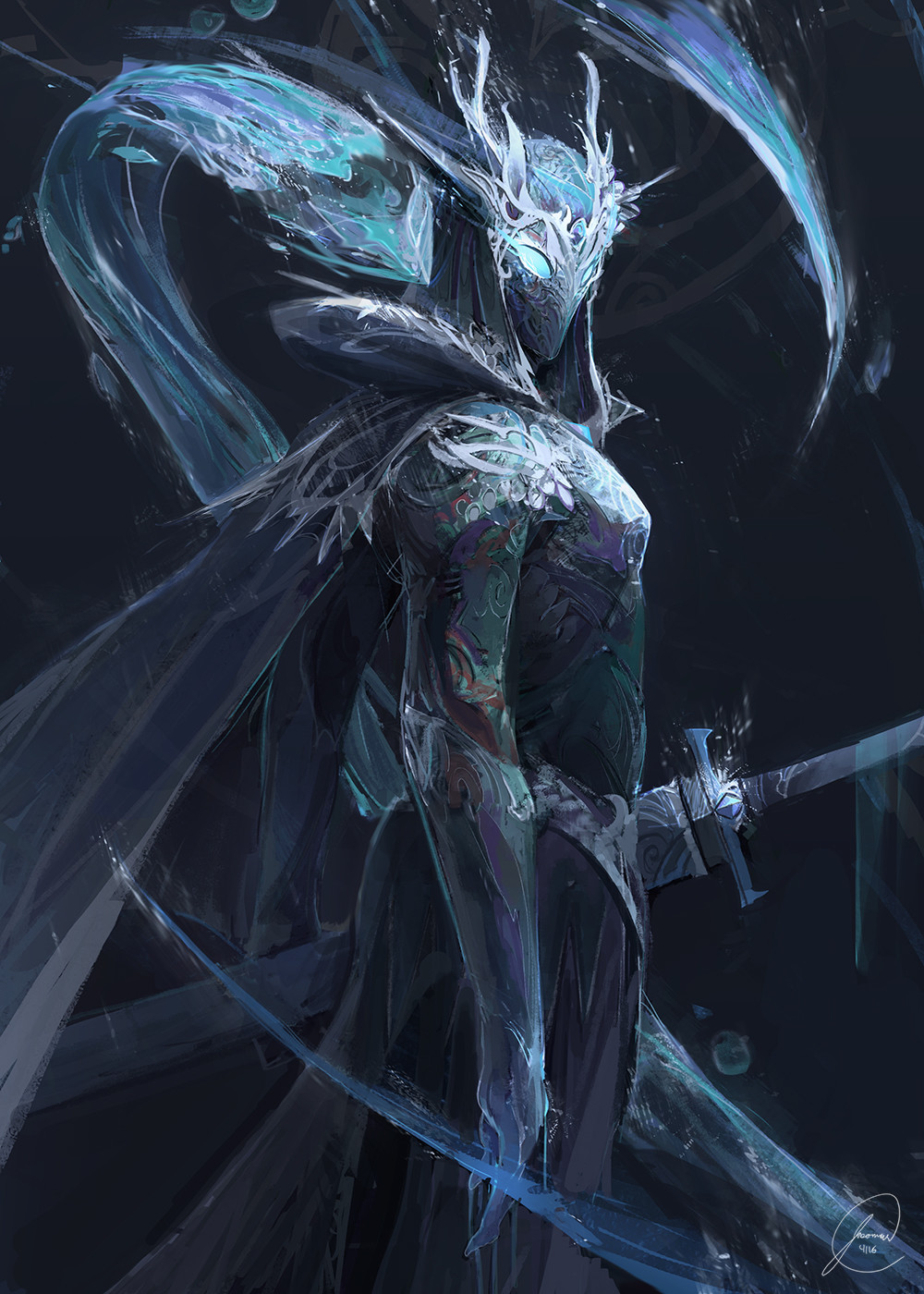

Aquatic Mount
When you reach 10th level, your sinister mount becomes aquatic in both appearance and power. It gains the following features:
Aquatic Type. Your sinister mount's creature type changes to one of the following of your choice (or can remain, if it is already one of the following): aberration, beast, fey, fiend, or monstrosity.
Amphibious. Your sinister mount can breathe both air and water.
Swimmer. Your sinister mount gains a swim speed of 60 feet.
Ink Cloud As an action, your sinister mount can release a cloud of ink. If it is underwater, this cloud extends around your sinister mount in a 20-foot radius. If above water, the radius is only 5 feet. Within the ink cloud, the area is heavily obscured for 1 minute, although a significant current or wind can disperse the ink. After releasing the ink, your sinister mount can take the Dash action as a bonus action. While within the ink, your sinister mount can take the Dodge or Hide action as a bonus action.
Sea Hag Servant
At 14th level, once per long rest, you gain the ability to temporarily conjure a sea hag to your service. The summoned hag is friendly to you and your companions. Roll initiative for the hag, which has its own turns. They obey any verbal commands that you issue to them (no action required by you). If you don't issue any commands to them, they defend themselves from hostile creatures, but otherwise take no actions. The hag remains for 1 hour, but does not require concentration.
While the sea hag is summoned in this manner, you or they can use your bonus action to instantaneously swap places through a Watery Warp if you are within 60 feet of each other. You can collectively use this feature a number of times equal to your Charisma modifier.
Ghost Ship
At 18th level, you gain the ability to conjure a ghostly ship from the depths of the ocean. As an action, choose a point within 300 feet of you that you can see. You create a specter of a shipwrecked sailing ship for 24 hours. This ship shares the statistics of the Sailing Ship in Ghosts of Saltmarsh, with the following changes:
- The ship gains a flying pace equal to half its travel pace. Likewise, its sails gain a fly speed of 20 feet, or 5 feet against the wind, and 30 feet with the wind.
- The ship is resistant to bludgeoning, piercing, and slashing damage from nonmagical attacks.
- The ship is immune to necrotic damage.
- The ship is crewed by ephemeral ghosts who obey your commands and run the ship, but who cannot otherwise interact with you, other creatures, or the environment in any way. When you approach these ghosts, they lack definite features, and seem to stare past you.
- The ballista instead deals cold damage.
- The mangonel instead deals necrotic damage.
Once you have used this feature, you cannot use it again for 2d6 days.
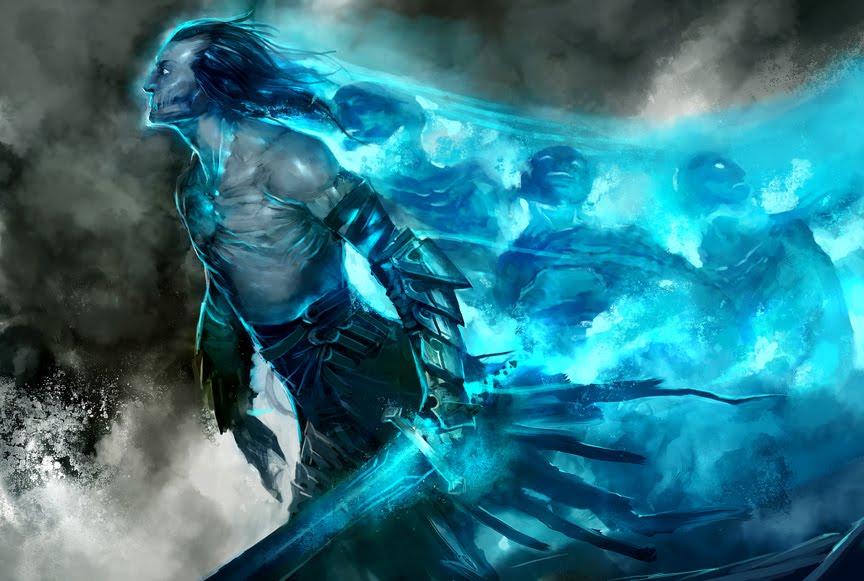

Ghost Knight
The power of death knights comes partially from their connection to the dead and undead. Those of this paradigm forge especially strong connections with undead spirits, gaining ethereal abilities alongside the aid of the spirits themselves.
Ghostly Resistance
When you chose this Deathly Paradigm at 3rd level, you gain resistance to one of the following damage types of your choice: nonmagical bludgeoning, nonmagical piercing, or nonmagical slashing.
Grim Reaping: Telekinetic Thrust
You learn this Reaping option when you choose this Deathly Paradigm at 3rd level.
When you use your Grim Reaping feature, you target a creature or unattended object within 30 feet of you. A creature must be your size or smaller to be affected by this magic, and an object can weigh up to 200 pounds.
If the target is a creature, you make a Charisma ability check (with proficiency) contested by the target's Strength (Athletics) check. If you win the contest, you hurl the target up to 30 feet in any direction, including upward. If the target then comes into contact with a hard surface or heavy object, the target takes 1d6 damage per 10 feet moved, and takes additional damage equal to your spellcasting ability modifier.
If the target is an object that isn't being worn or carried, you hurl it up to 30 feet in any direction. You can use the object as a ranged weapon, attacking one creature along the object's path (using your spell attack modifier for the attack roll) and dealing bludgeoning damage equal to 2d4 + your spellcasting ability modifier on a hit.
Ghost Knight Spells
| Death Knight Level | Spells |
|---|---|
| 3rd | chill touch, fog cloud, unseen servant |
| 5th | invisibility, misty step |
| 9th | gaseous form, spirit shroud |
| 13th | compulsion, greater invisibility |
| 17th | animate objects, steel wind strike |
Ghostly Luminescence
Starting at 6th level, as a bonus action, you can illuminate yourself with ghostly light. When you do this, you shed bright light in a 5 to 20 foot radius (your choice) and dim light for an additional number of feet equal to the chosen radius. You can alter the size of this radius or dismiss it as a bonus action.
Create Specter
When you reach 10th level, you develop the capability to create specters to serve you. As an action, you target a humanoid within 10 feet of you that has been dead for no longer than 1 minute and died violently. The target's spirit rises as a specter in the space of its corpse or in the nearest unoccupied space. The specter is under your control and remains until it is reduced to 0 hit points or until it is dismissed by you as a bonus action. You can have no more than seven specters under your control at one time.
The statistics for specters can be found in the Monster Manual. As a bonus action on each of your turns, you can mentally command one of these specters if it is within 120 feet of you (if you control multiple undead creatures, you can
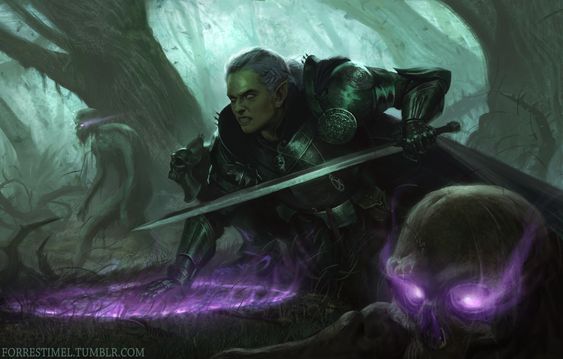

command any or all of them at the same time, issuing the same command to each one). You decide what action the specter will take and where it will move during its next turn, or you can issue a general command, such as to guard a particular chamber or corridor. If you issue no commands, the specter only defends itself against hostile creatures. Once given an order, the specter continues to follow it until its task is complete or until it receives new orders.
You can use this feature a number of times equal to half your proficiency bonus (rounded down), regaining any expended uses on finishing a short or long rest.
Spectral Mount
When you reach 10th level, your sinister mount becomes spectral in both appearance and power. It gains the following features:
Undead Type. Your sinister mount's creature type changes to undead if it wasn't already.
Ethereal Resistance. Your sinister mount is resistant to nonmagical bludgeoning, piercing, and slashing damage.
Incorporeal Movement. Your sinister mount can move through other creatures and objects as if they were difficult terrain. It takes 1d10 force damage if it ends its turn inside an object. This feature is conferred upon its rider.
Consume Life. As a bonus action, after your sinister mount kills a creature (or after you kill a creature while riding it), it regains 3d6 hit points.
Innate Etherealness
Starting at 14th level, you may cast etherealness on yourself as an action once per long rest without expending a spell slot.
Spectral Possession
When you reach 18th level, you gain the ability to take on a spectral form to possess a creature as an action. One humanoid that you can see within 5 feet of you must succeed on a Charisma saving throw (against your spell save DC) or be possessed by you; you then disappear, and the target is incapacitated and loses control of its body. You now control
the body but don't deprive the target of awareness. You can't be targeted by any attack, spell, or other effect, except ones that turn undead, and you retain your alignment, Intelligence, Wisdom, Charisma, and immunity to being frightened. You otherwise use the possessed target's statistics, but don't gain access to the target's knowledge, class features, or proficiencies.
The possession lasts until the body drops to 0 hit points, you end it as a bonus action, or you are turned or forced out by an effect like the dispel evil and good spell. When the possession ends, you reappear in an unoccupied space within 5 feet of the body. The target is immune to your Spectral Possession for 24 hours after succeeding on the saving throw or after the possession ends.
You may use this feature once per long rest.
Grave Knight
Death knights of this paradigm have a particularly strong connection to the physical corpses of the dead and undead, as well as the concepts of burial and decay. Invigorated and assisted by the dead around them, they can unlock great power.
Mortality Proficiency
When you choose this Deathly Paradigm at 3rd level, you become proficient in either the Religion or Survival skill (your choice).
Grim Reaping: Funeral March
You learn this Reaping option when you choose this Deathly Paradigm at 3rd level.
When you use your Grim Reaping feature, the creature you reaped is briefly puppeted with your necromantic power. Even though it has 0 hit points, you may control the creature on its next turn. At the end of this turn, you lose control and the creature's corpse becomes truly lifeless.
Grave Knight Spells
| Death Knight Level | Spells |
|---|---|
| 3rd | toll the dead, grave hook, sleep |
| 5th | gentle repose, silence |
| 9th | animate dead, feign death |
| 13th | aura of life, blight |
| 17th | danse macabre, raise dead |
Death's Invigoration
Starting at 6th level, whenever an enemy dies within 30 feet of you, you regain hit points equal to your Charisma modifier + half your Death Knight level (rounded down).
Reanimator
Starting at 10th level, you may cast animate dead once without expending a spell slot. You regain the use of this feature after finishing a short or long rest.
Marshal Undead
Starting at 10th level, unless you are incapacitated, any undead creatures of your choice within 60 feet of you have advantage on saving throws against effects that turn undead.
Decaying Mount
When you reach 10th level, your sinister mount takes on a decaying appearance, which empowers it. It gains the following features:
Undead Type. Your sinister mount's creature type changes to undead if it wasn't already.
Undead Fortitude. When reduced to 0 hit points, your sinister mount must make a Constitution saving throw with a DC of 5 + half the damage taken. On a success, it drops to 1 hit point instead.
Necrotic Attacks. Your sinister mount's attacks gain an additional 1d6 necrotic damage.
Decaying Aura. Unfriendly creatures within 5 feet of your sinister mount are vulnerable to acid and necrotic damage (or if they are resistant, they lose their resistance). Constructs and undead are immune to this effect.
Gravedigger
Beginning at 14th level, you may magically tunnel underneath the ground and move underground as though through difficult terrain. You may do this while riding your Sinister Mount as well. Your ability to tunnel in this way is blocked by 1 inch of metal or lead. When tunneling through stone, you move at 1/3 speed. Other creatures may follow the path of your tunnel, though the tunnel is subject to structural risks, such as partial or full cave-ins.
Undead Commander
Starting at 18th level, any undead creatures of your choice within 300 feet of you have temporary hit points equal to your Charisma modifier + half your death knight level (rounded down). If a creature leaves this radius, they lose this bonus, and may not regain it until you finish a long rest.
Undying Nature
Beginning at 18th level, you can hold your breath indefinitely, and you don't require food, water, or sleep, although you still
require rest to reduce exhaustion and still benefit from finishing short and long rests.
In addition, your life is extended significantly. For every 10 years that pass, you age only 1 year, although your body will still appear to age and decay as normal, and you are immune to being magically aged.
Infernal Knight
Those of this deathly paradigm develop a connection with the nine hells. These death knights unlock devilish and hellish powers, perhaps through worship of devils or simply the allure of the power that the infernal can offer them. Regardless, they may grow to rival the might of archdevils.
Infernal Lexicon
When you choose this Deathly Paradigm at 3rd level, you learn to speak, read, and write Infernal.
Grim Reaping: Hellish Weapons
You learn this Reaping option when you choose this Deathly Paradigm at 3rd level.
When you use your Grim Reaping feature, your weapons become infused with hellish power. For the next minute, your weapon attacks deal an additional 1d4 damage of one of the following types of your choice: cold, fire, or poison.
Infernal Knight Spells
| Death Knight Level | Spells |
|---|---|
| 3rd | shocking grasp, burning hands, hellish rebuke |
| 5th | enthrall, heat metal |
| 9th | fireball, flame arrows |
| 13th | fire shield, wall of fire |
| 17th | immolation, infernal calling |
Layer Link
When you reach 6th level in this class, you develop an arcane link with a layer of the Nine Hells. Choose one of the layers from the table below, gaining its features. This choice also determines the features you gain at 18th level.
When you reach 14th level, you develop a second link. Choose one more layer from the table, gaining its features. This choice also determines the features you gain at 18th level.
| Layer | Feature |
|---|---|
| Avernus | Fiery Comet. When you use your Dark Sacrifice feature, you may conjure a small fiery comet that slams down into another enemy within 30 feet of your target. The new target must make a Dexterity saving throw, taking two thirds of the damage dealt by your Dark Sacrifice on a failed save as fire damage (rounded down), or half that fire damage on a successful one. |
| Dis | Dispater's Disposition. You become proficient with smith's tools and one of the following skills of your choice: Deception, Insight, or Persuasion. |
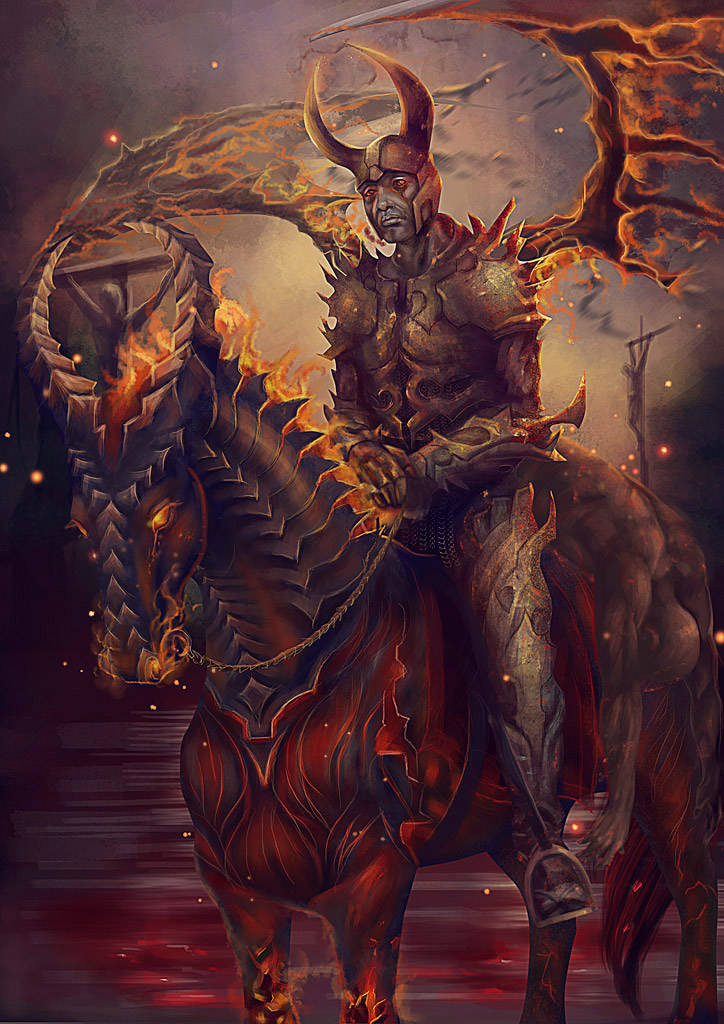

| Layer | Feature |
|---|---|
| Minauros | Spells of Greed. The spells distort value, incite greed and jim's glowing coin are added to the Death Knight spell list for you and you always have them prepared (they do not count toward your total number of spells prepared). |
| Phlegethos | Fire Resistance. You become resistant to fire damage. |
| Stygia | Communication Magic. You learn the message cantrip and it does not count toward your total number of cantrips known. Additionally, beast bond, detect thoughts, sending, arcane eye, and rary's telepathic bond are added to the Death Knight spell list for you, which you may prepare as part of your prepared spells so long as you have a high enough spell slot to cast them. |
| Malbolge | Slope Climber. Your climb speed increases to match your walk speed if it doesn't already. Otherwise, it simply increases by 10 feet. |
| Maladomini | Street Fighter. You may add your Charisma modifier to all weapon attack rolls you make while in urban terrain, and half your Charisma modifier (rounded down) to the damage rolls of both weapon and spell attacks in urban terrain. |
| Cania | Cold Resistance. You become resistant to cold damage. |
| Nessus | Devil's Sight. You can now see normally in darkness, both magical and nonmagical, to a distance of 120 feet. |
Infusion of the Nine Hells
When you reach 10th level, you gain the ability to infuse a spell or attack with infernal power from all nine layers of hell. When you successfully land a weapon or spell attack, you may use your bonus action to infuse it with hellish power. When you do this, the target takes an additional 1d4 damage of each of the following types: acid, bludgeoning, cold, fire, force, lightning, necrotic, piercing, and radiant.
You may use this feature a number of times equal to half your Charisma modifier, rounded down (minimum of once). You regain any expended uses after finishing a long rest.
Devilish Mount
When you reach 10th level, your sinister mount becomes devilish in both appearance and power. It gains the following features.
Fiend Type. Your sinister mount's creature type changes to fiend if it wasn't already.
Hellish Resistance. Your sinister mount becomes resistant to two of the following damage types of your choice: cold, fire, or poison.
Devilish Sight. Your sinister mount gains 60 feet of darkvision (if it already had darkvision, it gains an additional 60 feet) which cannot be impeded by magical darkness.
Hellish Attacks. Your sinister mount's attacks gain an additional 1d6 damage of one of the following types of your choice: cold, fire, or poison.
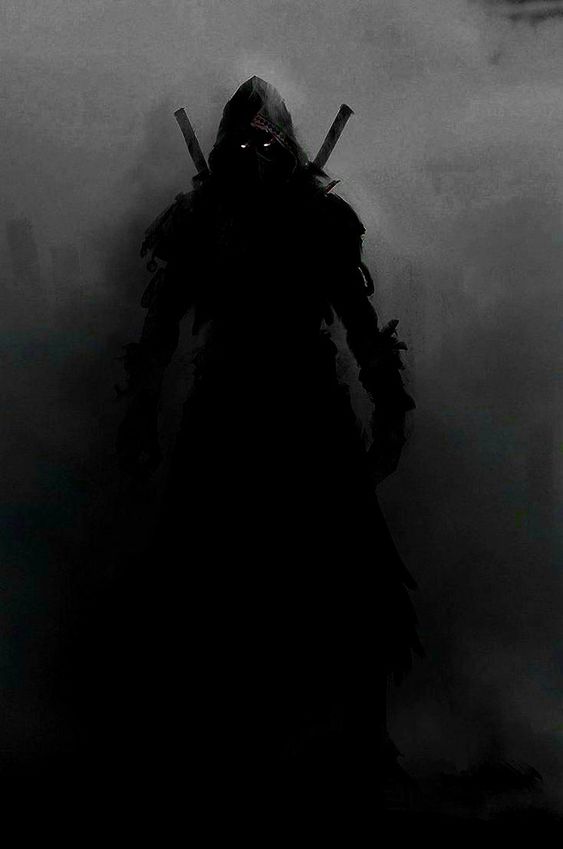

Infernal Exaltation
When you reach 18th level, you gain two of the features detailed in the table below based on the Layer Links you choose at 6th and 14th levels.
| Layer | Feature |
|---|---|
| Avernus | Insect Mutation. You may cast the giant insect spell once per long rest without expending a spell slot or having the spell prepared. |
| Dis | Blood and Iron. You may cast the cloud of daggers spell at 4th level once per long rest without expending a spell slot or having the spell prepared. |
| Minauros | Putrid Engulfment. You may cast the vitriolic sphere spell once per long rest without expending a spell slot or having the spell prepared. |
| Phlegethos | Flames of Phlegethos. You learn the Flames of Phlegethos feat, even if you are not a tiefling. However, you must choose one of your ability scores to decrease by 1. |
| Stygia | Ice and Lightning. You may cast armor of agathys and call lightning once per long rest each without expending a spell slot or having the spells prepared. |
| Malbolge | Unstable Ground. You may cast maximilian's earthen grasp and earth tremor at 2nd level once per long rest each without expending a spell slot or having the spells prepared. |
| Maladomini | Arcane Tower. Once per long rest, you may cast galder's tower at 4th level without expending a spell slot or having the spell prepared. |
| Cania | Wintry Torrent. You may cast ice storm once per long rest without expending a spell slot or having the spell prepared. |
| Nessus | Magic of the Deepest Pit. Once per long rest each, you may cast feather fall, magnify gravity, and darkness without expending a spell slot or having the spells prepared. |
Shadow Knight
For some death knights, the path of shadow they take may be more literal. Those of this deathly paradigm attain power with and through darkness and shade, making them nocturnal predators proficient with not only magic and weapons, but stealthiness as well.
Clandestine Proficiency
When you choose this Deathly Paradigm at 3rd level, you become proficient in either the Sleight of Hand or Stealth skill (your choice).
Enhanced Darkvision
When you choose this Deathly Paradigm at 3rd level, you gain darkvision out to a range of 120 feet. If you already have darkvision from your race, its range increases by 60 feet.
Grim Reaping: Shadow Meld
You learn this Reaping option when you choose this Deathly Paradigm at 3rd level.
When you use your Grim Reaping feature, if you are within dim light or darkness, you meld with the shadows around
you, becoming invisible for the next minute. While invisible, you have advantage on Dexterity (Sleight of Hand) and Dexterity (Stealth) checks. The effect ends if you attack or cast a spell. If you attack or cast a spell while invisible in this way, you have advantage on the roll, and targets have disadvantage on any saving throws they have to make.
Shadow Knight Spells
| Death Knight Level | Spells |
|---|---|
| 3rd | minor illusion, false life, silent image |
| 5th | darkness, shadow blade |
| 9th | nondetection, summon shadowspawn |
| 13th | mordenkainen's faithful hound, shadow of moil |
| 17th | creation, negative energy flood |
Strength Drain
When you reach 6th level, you gain the ability to drain your enemies' strength with shadowy energy. You my use this feature as an unarmed strike (with which you are proficient), using either your Constitution or Charisma modifier for the attack and damage rolls (your choice when you make the attack). On a hit, the target takes 2d6 necrotic damage, plus the chosen ability modifier, and its Strength score is reduced by 1d4. The target dies if this reduces its Strength to 0. Otherwise, the reduction lasts until the target finishes a short or long rest.
If a non-evil humanoid dies from this attack, a shadow (see Monster Manual) rises from the corpse 1d4 hours later, and it is under your control so long as you maintain concentration (as if concentrating on a spell).
You can use this feature a number of times equal to your proficiency bonus, regaining any expended uses after finishing a long rest.
Shadow Amorphousness
When you reach 10th level, you may move through spaces as narrow as one inch wide without squeezing by temporarily transmuting yourself into shadow. This does not take any additional movement. This feature is conferred upon your sinister mount while you are riding it. If you or your sinister mount attempt to end your turn in a space narrower than your corporeal form, you take 1d10 force damage and are pushed to the nearest unoccupied space.
Umbral Mount
When you reach 10th level, your sinister mount becomes shadowy in both appearance and power. It gains the following features:
Shadowy Type. Your sinister mount's creature type changes to one of the following of your choice (or can remain, if it is already one of the following): elemental, fiend, or undead.
Blindsight. Your sinister mount gains 30 feet of blindsight (if it already had blindsight, it gains an additional 30 feet).
Shadow Stealth. While in dim light or darkness, your sinister mount can take the Hide action as a bonus action, and it has advantage on this Dexterity (Stealth) check. This ability is conferred upon its rider.
Darkness Aura. Your sinister mount can use this feature once per long rest. A 15-foot radius of magical darkness extends out from the mount, moves with it, and spreads around corners. The darkness lasts as long as the mount maintains concentration, up to 10 minutes (as if concentrating on a spell). Darkvision can't penetrate this darkness, and no natural light can illuminate it. If any of the darkness overlaps with an area of light created by a spell of 2nd level or lower, the spell creating the light is dispelled.
Shadow Walk
At 14th level, you gain the ability to step from one shadow into another. When you are in dim light or darkness, as a bonus action, you can teleport up to 120 feet to an unoccupied space you can see that is also in dim light or darkness. This feature is conferred upon your sinister mount while you are riding it.
Living Shadow
Starting at 18th level, while in dim light or darkness, you have resistance to all damage that isn't force, psychic, or radiant.
Venom Knight
One of nature's most sure and powerful paths toward death is poison and venom. Death knights of this paradigm focus their training and the development of their powers on this toxic ideal, becoming masters of virulent violence.
Superior Poison Resistance
Starting at 3rd level when you choose this Deathly Paradigm, you have resistance to poison damage and advantage on saving throws against being poisoned.
Grim Reaping: Venomous Violence
You learn this Reaping option when you choose this Deathly Paradigm at 3rd level.
When you use your Grim Reaping feature, your first successful weapon attack each turn for the next minute deals extra poison damage equal to 1d4 + half your Death Knight level (rounded down) and leaves the creature poisoned until the start of your next turn.
Venom Knight Spells
| Death Knight Level | Spells |
|---|---|
| 3rd | infestation, poison food and drink*, ray of sickness |
| 5th | protection from poison, web |
| 9th | plant growth, stinking cloud |
| 13th | giant insect, toxify blood* |
| 17th | cloudkill, contagion |
Expert Poisoner
When you reach 6th level, you gain proficiency with the poisoner's kit if you do not already have it. Additionally, you may double your proficiency bonus for any ability checks you make with your poisoner's kit.
Whenever you craft a poison, you may add poison damage equal to twice your Intelligence or Wisdom modifier (your choice upon crafting) [minimum of 1 poison damage] to the effects of the poison.
Also, you may apply poison to a weapon or piece of ammunition as a bonus action, rather than an action.
Mephitic Magic
Starting at 10th level, whenever you cast a death knight spell that deals damage, you may change the damage type to poison at will.
Venomous Technique
Startingat 10th level, whenever you deal poison damage with a spell, weapon, poison, or other feature, you may add your proficiency bonus to the total poison damage.
Starting at 18th level, you may also add your Charisma modifier to the total poison damage. If you already added your Charisma modifier to the damage, add it again.
Toxic Mount
When you reach 10th level, your sinister mount becomes toxically empowered, taking on either a serpentine or plantlike appearance. It gains the following features:
Toxic Type. Your sinister mount's creature type changes to one of the following of your choice (or can remain, if it is already one of the following): elemental, fey, monstrosity, or plant.
Enhanced Poison Immunity. Your sinister mount is immune to poison damage and being poisoned.
Toxic Attacks. Your sinister mount's attacks deal an additional 1d6 poison damage.
Poisonous Body. When a creature within 5 feet lands a successful melee attack against your sinister mount, it must succeed on a Constitution saving throw (Save DC = 10 + your sinister mount's Constitution modifier) or be poisoned until the end of its next turn.
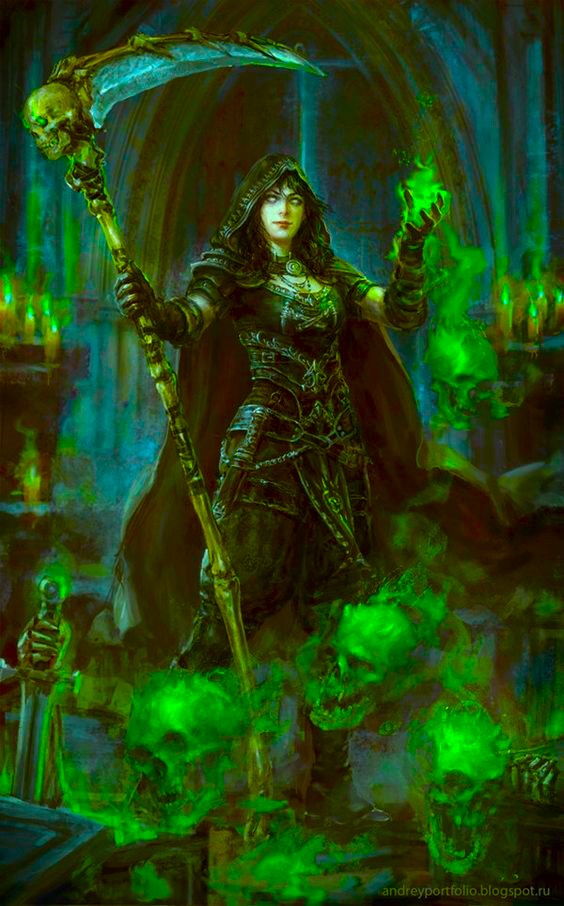

Conjure Poisonous Creatures
When you reach 14th level, you gain the ability to use this feature once per long rest as if casting a spell without expending a spell slot. As an action, you summon fey spirits that take the form of poisonous creatures and appear in unoccupied spaces within 60 feet of you. The possible forms of these creatures are shown in the table at the end of this feature's description. Choose one of the following options for what appears:
- One creature of challenge rating 2 or lower
- Two creatures of challenge rating 1 or lower
- Four creatures of challenge rating 1/2 or lower
- Eight creatures of challenge rating 1/4 or lower
- Ten creatures of challenge rating 1/8 or lower
- Eleven creatures of challenge rating 0
Each creature is also considered fey (regardless of its original creature type), and it disappears when it drops to 0 hit points or when the spell ends. The spell ends if you lose concentration or dismiss it manually as a bonus action.
The summoned creatures are friendly to you and your companions. Roll initiative for the summoned creatures as a group, which has its own turns. They obey any verbal commands that you issue to them (no action required by you). If you don't issue any commands to them, they defend themselves from hostile creatures, but otherwise take no actions.
When you reach 18th level, you may summon twice as many creatures, or you may summon one creature from the table of challange rating 4 or lower.
| CR | Creatures |
|---|---|
| 0 | chimeric baboon, homunculus, infant basilisk, myconid sprout, scorpion, spider, stool |
| 1/8 | flying snake, flumph, neogi hatchling, poisonous snake |
| 1/4 | animated jade serpent, dretch, giant centipede, giant poisonous snake, giant wolf spider, hellwasp grub, male steeder, pseudodragon |
| 1/2 | amphisbaena, gas spore, giant wasp, metal wasp, myconid adult, swarm of centipedes, tri-flower frond |
| 1 | female steeder, giant flying spider, giant spider, ice spider, imp, quasit, spider king, thri-kreen, young basilisk |
| 2 | carrion crawler, carrion ogre, ettercap, green dragon wyrmling, ice spider queen, myconid sovereign, purple wormling, swarm of poisonous snakes, swarm of undead snakes, vegepygmy chief |
| 3 | assassin vine, basilisk, bearded devil, bulezau, carrion stalker, choldrith, giant scorpion, grell, neogi, nergaliid, phase spider, yuan-ti malison, yuan-ti priest |
| 4 | chardalyn berserker, chuul, couatl, drowned assassin, eku, kamadan, neogi master, poison weird, snake horror |
Virulent Venoms
Starting at 18th level, any spells, weapons, poisons, or other features you use or create that deal poison damage now
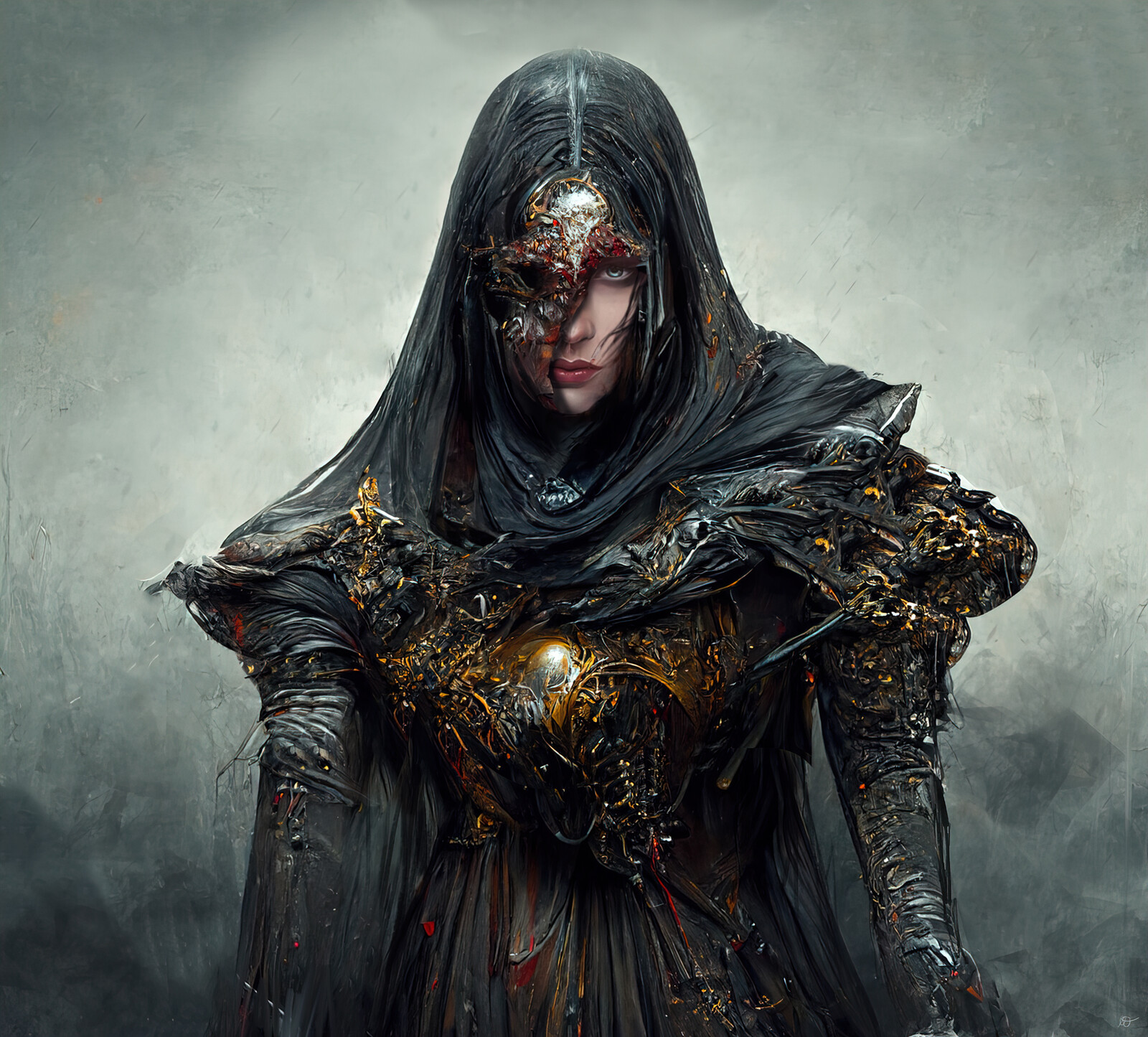

ignore resistance to poison damage. If a target is immune to poison damage, the immunity is instead treated as resistance.
Vermin Knight
Rodents, insects, and other vermin are sometimes regarded as carriers of disease and death, and they often are. Death knights of this paradigm empower themselves with the aid of such vermin, using their capabilities to spread death among their enemies.
Speak with Small Beasts
Through sound and gestures, you may communicate simple ideas with Small or smaller beasts.
Grim Reaping: Corpse-Spawned Swarm
You learn this Reaping option when you choose this Deathly Paradigm at 3rd level.
When you use your Grim Reaping feature, you magically spawn a swarm of vermin from the remains of the triggering enemy. The swarm is under your control (no action required by you) and takes its turn immediately following yours. Choose one of the following to summon: swarm of beetles, swarm of centipedes, swarm of rot grubs, swarm of spiders, or swarm of wasps. Alternatively, you may summon two swarms of your choice of the following: swarm of bats, swarm of rats, or skeletal rats.
Vermin Knight Spells
| Death Knight Level | Spells |
|---|---|
| 3rd | infestation, detect poison and disease, ray of sickness |
| 5th | enlarge/reduce, spider climb |
| 9th | stinking cloud, tiny servant |
| 13th | dominate beast, giant insect |
| 17th | contagion, insect plague |
Vermin Spies
Starting at 6th level, you you have advantage on any Charisma-based ability checks with rodents, insects, arachnids, and bats. All such vermin start out as friendly to you. You can communicate with these vermin telepathically so long as they are within 30 feet of you.
Starting at 14th level, you can see through the eyes of any vermin spying for you and you can hear what they hear, so long as they are within a number of miles of you equal to your proficiency bonus. They are now compelled to follow your commands with no Charisma-based ability check required.
Conjure Vermin
When you reach 10th level, you gain the ability to use this feature once per long rest as if casting a spell without expending a spell slot. As an action, you summon aberrant spirits that take the form of vermin-like creatures and appear in unoccupied spaces within 60 feet of you. The possible forms of these creatures are shown in the table at the end of this feature's description. Choose one of the following options for what appears:
- One creature of challenge rating 2 or lower
- Two creatures of challenge rating 1 or lower
- Four creatures of challenge rating 1/2 or lower
- Eight creatures of challenge rating 1/4 or lower
- Ten creatures of challenge rating 1/8 or lower
- Eleven creatures of challenge rating 0
Each creature is also considered an aberration (regardless of its original creature type), and it disappears when it drops to 0 hit points or when the spell ends. The spell ends if you lose concentration or dismiss it manually as a bonus action.
The summoned creatures are friendly to you and your companions. Roll initiative for the summoned creatures as a group, which has its own turns. They obey any verbal commands that you issue to them (no action required by you). If you don't issue any commands to them, they defend themselves from hostile creatures, but otherwise take no actions.
When you reach 14th level, you may summon twice as many creatures.
| CR | Creatures |
|---|---|
| 0 | baboon, badger, bat, chimeric baboon, chimeric fox, chimeric rat, cranium rat, crow, giant fire beetle, infant basilisk, infant hook horror, lizard, quipper, rat, scorpion, sorrowfish, spider, stool, vulture |
| 1/8 | giant rat, gremishka, hoard scarab, neogi hatchling, slaad tadpole, stirge |
| 1/4 | abyssal chicken, bone whelk, cave badger, gazer, giant badger, giant bat, giant centipede, giant snail, giant wolf spider, hellswap grub, ixitxachitl, male steeder, violet fungus |
| 1/2 | darkmantle, fiendish giant spider, giant sea eel, ice piercer, metal wasp, piercer, rust monster, stench kow, zorbo |
| 1 | core spawn crawler, female steeder, giant flying spider, giant vulture, giant wasp, thorny vegepygmy, young basilisk |
| 2 | ankheg, carrion crawler, egg hunter hatchling, grick, intellect devourer, meenlock, vampiric ixitxachitl |
Vile Mount
When you reach 10th level, your sinister mount becomes vile in both appearance and power. It gains the following features:
Vile Type. Your sinister mount's creature type changes to one of the following of your choice (or can remain, if it is already one of the following): aberration, beast, or monstrosity.
Keen Hearing and Smell. Your sinister mount has advantage on Wisdom (Perception) checks that rely on hearing or smell.
Spider Climb. Your sinister mount can move up, down, and across vertical surfaces - including upside-down along ceilings - using its movement speed. It can do this with a rider, and the rider has no difficulty maintaining their grip.
Toxic Blood. When a creature within 5 feet lands a successful melee attack against your sinister mount, it must succeed on a Constitution saving throw (Save DC = 10 + your sinister mount's Constitution modifier) or be poisoned until the end of its next turn.
Vermin Form
Starting at 18th level, you can use your action to magically assume the shape of a vermin of challenge rating 1 or less from the Conjure Vermin feature table. You can use this feature twice. You regain expended uses when you finish a long rest.
You can stay in a vermin shape for a number of hours equal to a quarter of your Death Knight level (rounded down). You then revert to your normal form unless you expend another use of this feature. You can revert to your normal form earlier by using a bonus action on your turn. You automatically revert if you fall unconscious, drop to 0 hit points, or die.
While you are transformed, the following rules apply:
- Your game statistics are replaced by the statistics of the vermin, but you retain your alignment, personality, and Intelligence, Wisdom, and Charisma scores. You also retain all of your skill and saving throw proficiencies, in addition to gaining those of the creature. If the creature has the same proficiency as you and the bonus in its stat block is higher than yours, use the creature's bonus instead of yours. If the creature has any legendary or lair actions, you can't use them.
- When you transform, you assume the vermin's hit points and Hit Dice. When you revert to your normal form, you return to the number of hit points you had before you transformed. However, if you revert as a result of dropping to 0 hit points, any excess damage carries over to your normal form, For example, if you take 10 damage in animal form and have only 1 hit point left, you revert and take 9 damage. As long as the excess damage doesn't reduce your normal form to 0 hit points, you aren't knocked unconscious.
- You can't cast spells, and your ability to speak or take any action that requires hands is limited to the capabilities of your vermin form. Transforming doesn't break your concentration on a spell you've already cast, however, or prevent you from taking actions that are part of a spell, such as insect plague, that you've already cast.
- You retain the benefit of any features from your class, race, or other source and can use them if the new form is physically capable of doing so. However, you can't use any of your special senses, such as darkvision, unless your new form also has that sense.
- You choose whether your equipment falls to the ground in your space, merges into your new form, or is worn by it. Worn equipment functions as normal, but the DM decides whether it is practical for the new form to wear a piece of equipment, based on the creature's shape and size. Your equipment doesn't change size or shape to match the new form, and any equipment that the new form can't wear must either fall to the ground or merge with it. Equipment that merges with the form has no effect until you leave the form.
Witch Knight
Magic is an essential part of the identity of a death knight. For those of this paradigm, it is also the focus. Expanding their arcane abilities beyond that of other death knights, they are still formidable martial foes, who may take a bit more of an occult approach to their training.
Bonus Cantrip
When you choose this Deathly Paradigm at 3rd level, you learn one additional cantrip of your choice from the druid, warlock, or wizard spell lists. It counts as a Death Knight cantrip for you but does not count toward your total number of cantrips known.
Grim Reaping: Arcane Yield
You learn this Reaping option when you choose this Deathly Paradigm at 3rd level.
When you use your Grim Reaping feature, the spell slot level requirement for casting your next spell of 5th level or lower is reduced by 1 for the next minute. For example, you could cast a 4th level spell using a 3rd level spell slot, or a 1st level spell as if it was a cantrip.
Witch Knight Spells
| Death Knight Level | Spells |
|---|---|
| 3rd | mage hand, find familiar, witch bolt |
| 5th | augury, levitate |
| 9th | bestow curse, hypnotic pattern |
| 13th | polymorph, mordenkainen's private sanctum |
| 17th | reincarnate, scrying |
Ritual Caster
Starting at 6th level, you have learned a number of spells that you can cast as rituals. These spells are written in a ritual book, which you must have in hand while casting one of them.
At 6th level, you acquire a ritual book holding two 1st-level spells of your choice. Choose one of the following classes: druid, warlock, or wizard. You must choose your spells from
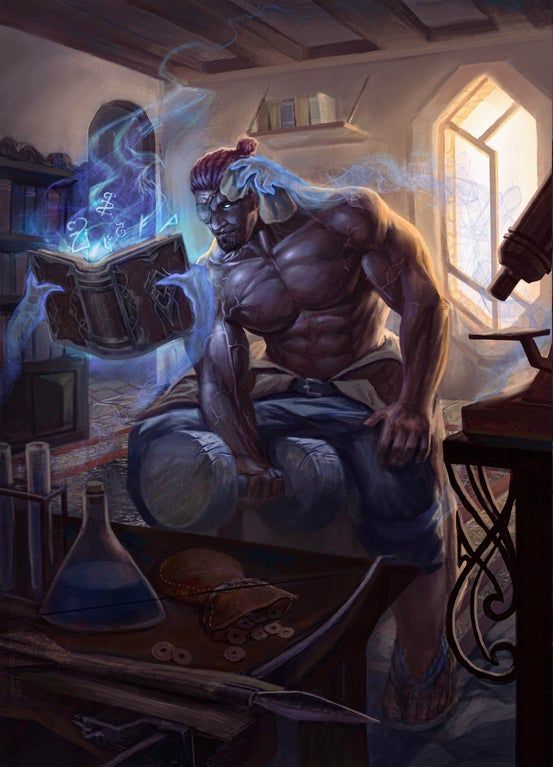

that class's spell list, and the spells you choose must have the ritual tag. Regardless of which class you choose, your spellcasting ability for these spells is Charisma. You can also cast any Death Knight spells you have prepared that have the ritual tag as rituals.
If you come across a spell in written form, such as a magical spell scroll or a wizard's spellbook, you might be able to add it to your ritual book. The spell must be on the spell list for the class you chose, the spell's level can be no higher than half your level (rounded up), and it must have the ritual tag. The process of copying the spell into your ritual book takes 2 hours per level of the spell, and costs 25 gp per level. The cost represents material components you expend as you experiment with the spell to master it, as well as the fine inks you need to record it. You can only cast the copied spells as rituals.
Arcane Recovery
Starting at 10th level, you have learned to regain some of your magical energy by ruminating on your spells. Once per day when you finish a short rest, you can choose expended spell slots of 4th level or lower to recover. The spell slots can have a combined level that is equal to or less than half your death knight level (rounded up).
Highly Potent Spellcasting
Starting at 10th level, you may add your Charisma modifier to the damage you deal with any death knight cantrip, and you may add half your Charisma modifier (rounded up) to the damage you deal with any death knight spell of 1st level or higher.
Witch's Mount
When you reach 10th level, your mount becomes infused with occult magic in both appearance and power. It gains the following features:
Magical Type. Your sinister mount's creature type changes to one of the following of your choice (or can remain, if it is already one of the following): celestial, fey, or fiend.
Arcane Flight. Your sinister mount has a flying speed of 30 feet (if it already has a flying speed, it gains an additional 15 feet of flying speed).
Magic Resistance. Your sinister mount has advantage on saving throws against spells and other magical effects.
Magical Attacks. Your sinister mount gains +1 to attack and damage rolls, and its attacks are considered magical.
Durable Magic
Beginning at 14th level, the magic you channel helps ward off harm. While you maintain concentration on a spell, you have a +2 bonus to AC and all saving throws.
Grand Magic
When you reach 18th level, you learn one 6th level spell of your choice from one of the druid, warlock, or wizard spell list. This counts as a death knight spell for you, but does not count toward the number of spells you prepare each day. You may cast this spell once, and cannot do so again until you finish a long rest.
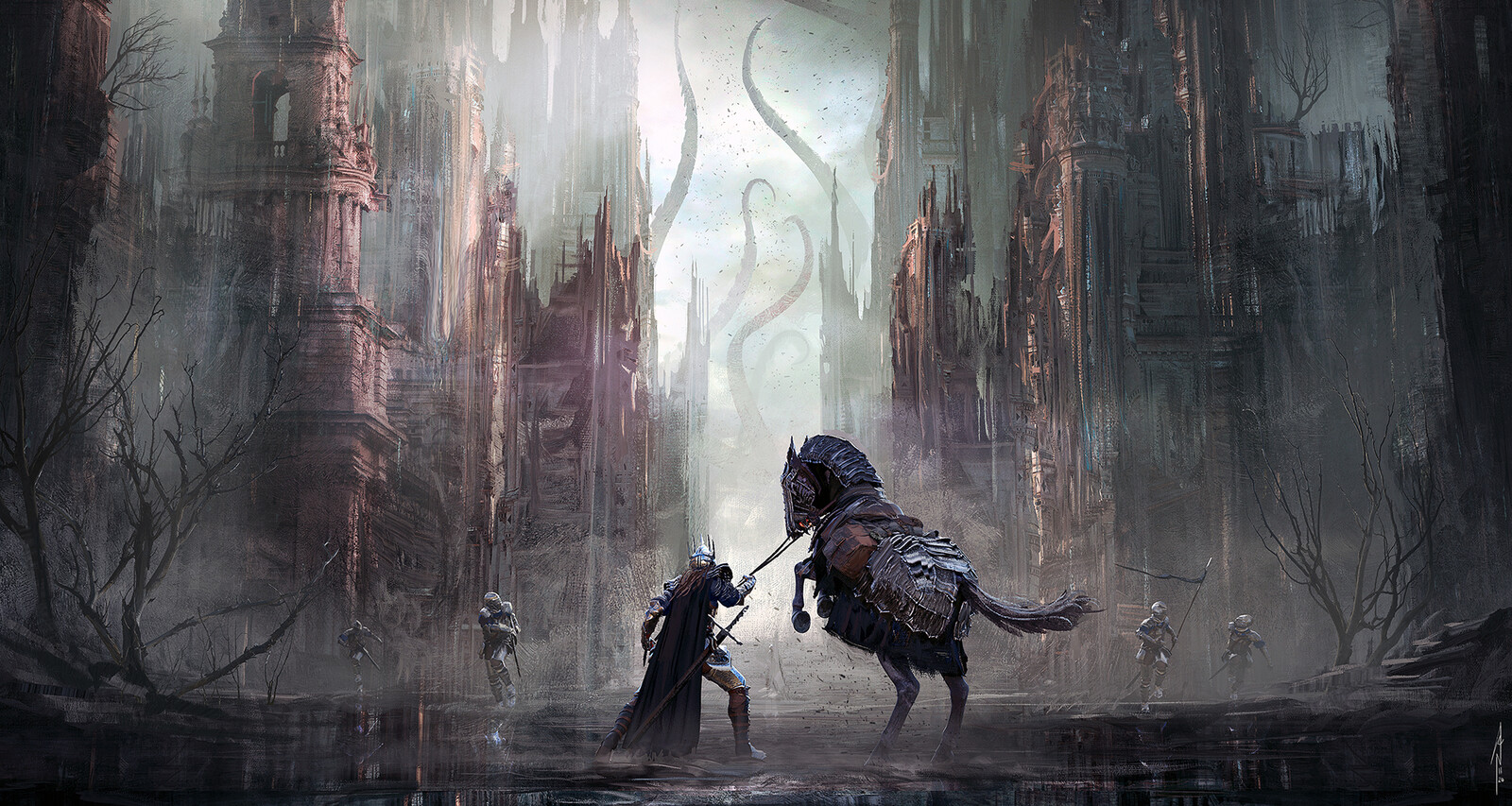

Death Knight
Cantrips (0 Level)
- Blade Ward
- Chill Touch
- Dancing Lights
- Frostbite
- Green-Flame Blade
- Infestation
- Poison Spray
- Primal Savagery
- Sapping Sting
- Spare the Dying
- Sword Burst
- Thaumaturgy
- Toll the Dead
- Trace of Mortality *
1st Level
- Armor of Agathys
- Bane
- Cause Fear
- Command
- Compelled Duel
- Detect Evil and Good
- Detect Poison and Disease
- False Life
- Frost Fingers
- Grave Hook *
- Hex
- Inflict Wounds
- Mage Armor
- Poison Food and Drink*
- Protection from Evil and Good
- Ray of Sickness
- Searing Smite
- Shield
- Tasha's Caustic Brew
- Wrathful Smite
2nd Level
- Blindness/Deafness
- Darkness
- Darkvision
- Enthrall
- Flame Blade
- Gentle Repose
- Hold Person
- Magic Weapon
- Melf's Acid Arrow
- Moonbeam
- Pass without Trace
- Ray of Enfeeblement
- See Invisibility
- Shadow Blade
- Spider Climb
- Undying Touch *
- Web
3rd Level
- Animate Dead
- Bestow Curse
- Dispel Magic
- Elemental Weapon
- Feign Death
- Glyph of Warding
- Life Transference
- Nightmare Horde *
- Revivify
- Speak with Dead
- Spirit Shroud
- Summon Undead
- Vampiric Touch
- Water Breathing
4th Level
- Banishment
- Blight
- Charm Monster
- Compulsion
- Death Ward
- Freeze Blood *
- Locate Creature
- Phantasmal Killer
- Shadow of Moil
- Sphere of Necrosis *
- Staggering Smite
- Toxify Blood *
- Vitriolic Sphere
5th Level
- Banishing Smite
- Cloudkill
- Contagion
- Danse Macabre
- Destructive Wave
- Dispel Evil and Good
- Enervation
- Geas
- Insect Plague
- Modify Memory
- Negative Energy Flood
- Parasitic Bond *
- Raise Dead
New Spell Desccriptions
The following section contains spell descriptions for new spells featured on the Death Knight spell list.
Freeze Blood
5th-level transmutation
- Casting Time: 1 action
- Range: 30 feet
- Components: V, S
- Duration: 1 minute
Icy energy springs from your fingertips toward a creature within range, freezing the creature's blood within its veins. The creature must make a Constitution saving throw. On a failed save, it takes 9d8 cold damage, its movement speed is halved for the duration, and it has disadvantage on Dexterity-based ability checks and saves for the duration. On a successful save, it takes half damage and its movement speed is only halved for its next turn.
This spell does not work against Constructs, Plants, or Undead.
Spell List(s): Death Knight, Sorcerer
Grave Hook
1st-level necromancy
- Casting Time: 1 action
- Range: Self (30-foot radius)
- Components: V, S, M (a thread and a pinch of graveyard dirt)
- Duration: Instantaneous
A tendril of dark energy with a hook at the end lashes out toward a creature within 30 feet of you. The creature must succeed on a Strength saving throw or take 2d10 necrotic damage and be pulled 15 feet by the most direct route toward you. The spell does its best to avoid obstacles when pulling a creature. On a successful save, a creature takes half damage and is not pulled.
At Higher Levels. When you cast this spell using a spell slot of 2nd level or higher, the damage increases by 1d10 for each slot level above 1st.
Spell List(s): Death Knight
Nightmare Horde
3rd-level necromancy
- Casting Time: 1 action
- Range: Self (30-foot cone)
- Components: V, S, M (a pinch of sand and a flake of dead flesh)
- Duration: Instantaneous
A horde of undead nightmarish spirits emerge from you and stampede in a 30-foot cone. All creatures in range must make a Wisdom saving throw. On a failed save, a creature takes 3d12 necrotic damage + 3d4 psychic damage and is frightened of you until the end of your next turn. On a successful save, a creature takes half damage and is not frightened.
At Higher Levels. When you cast this spell using a spell slot of 4th level or higher, the necrotic damage increases by 1d12 for each slot level above 3rd.
Spell List(s): Death Knight
Parasitic Bond
5th-level necromancy
- Casting Time: 1 action
- Range: Touch
- Components: V, S, M (a leech)
- Duration: Concentration, up to 1 minute
Make a melee spell attack against a creature within your reach. On a hit, the target takes 2d12 poison damage and 1d6 necrotic damage, and a link forms between the two of you. For the duration, so long as you are within 60 feet of the creature, you can use your bonus action to automatically deal 2d4 necrotic damage to the target. You regain hit points equal to half the damage dealt with these bonus actions.
Spell List(s): Death Knight
Poison Food and Drink
1st-level transmutation
- Casting Time: Ritual, 1 action
- Range: 10 feet
- Components: V, S
- Duration: Instantaneous
All nonmagical food and drink within a five-foot radius sphere centered on a point you choose is toxified, causing any creatures who consume it to be poisoned for 24 hours.
Spell List(s): Death Knight
Sphere of Necrosis
4th-level necromancy
- Casting Time: 1 action
- Range: 120 ft. (20-foot radius sphere)
- Components: V, S, M (a drop of decaying blood)
- Duration: Instantaneous
You point at a location within range, and a 1-foot diamter ball of grain-like shadowy energy streaks there and explodes in a 20-foot sphere. Each creature in the area must make a Constitution saving throw. On a failed save, a creature takes 6d8 necrotic damage, and is afflicted with necrosis for the next minute. During that time, it cannot regain hit points, and it takes an additional 1d6 necrotic damage at the start of each of its turns. A creature may repeat the saving throw at the end of each of its turns, ending the effect on itself on a success. A creature who succeeds on the initial saving throw takes half the initial damage and suffers no further effects.
Spell List(s): Death Knight
Toxify Blood
4th-level transmutation
- Casting Time: 1 action
- Range: 50 feet
- Components: V, S, M (a drop of bile and a rose thorn)
- Duration: 1 minute
Choose a willing creature you can see. Stretching forth your hand toward the creature and uttering incantations, you toxify their blood. This subtracts 1 from their armor class, but every time a creature within 5 feet hits them with a melee attack, the attacking creature must make a Dexterity saving throw. On a failed save, they take 3d8 poison and 1d6 acid damage. On a successful save, they take half damage.
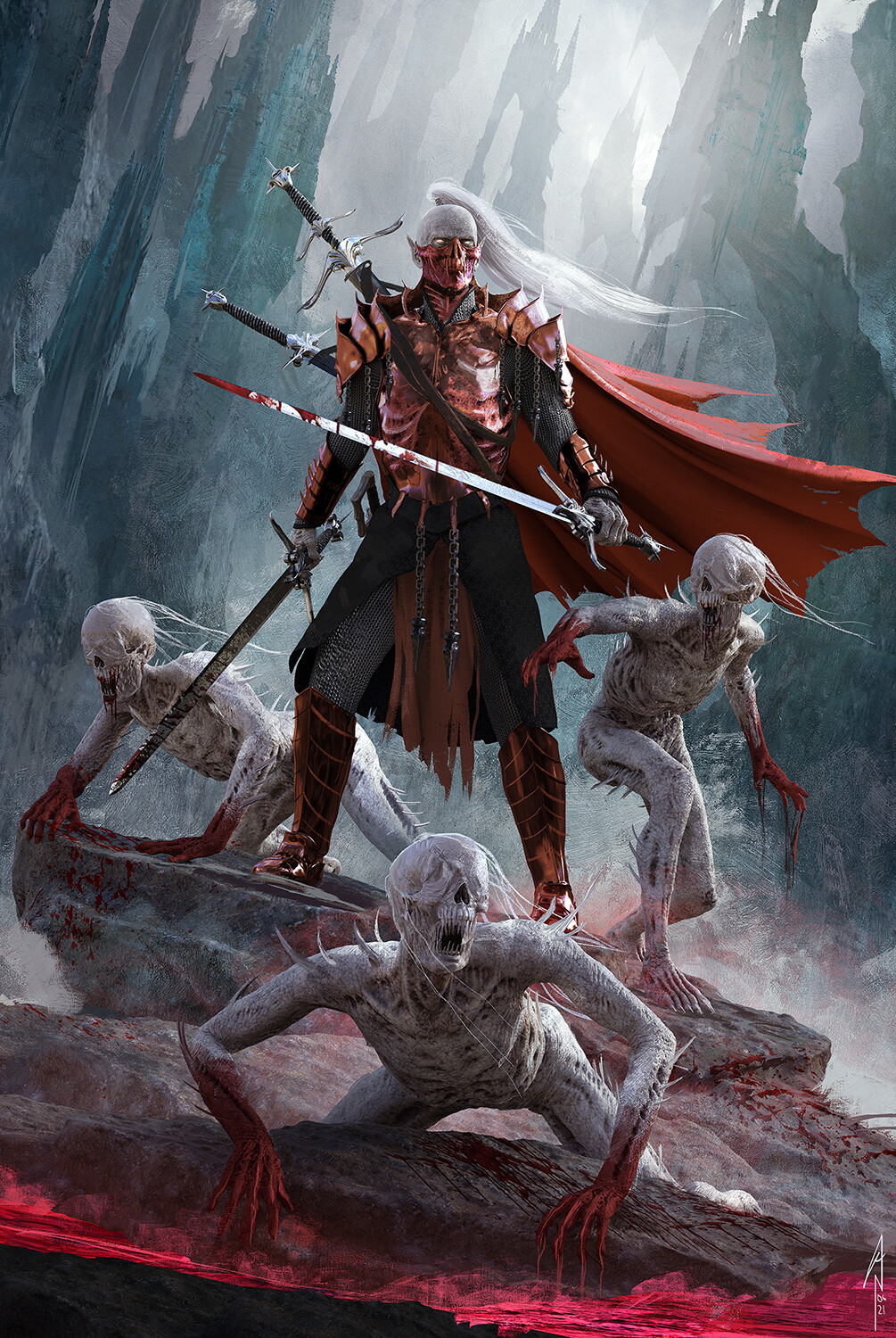

At Higher Levels. The poison damage increases by 1d8 and the acid damage increases by 1d6 for each slot level above 4th.
Spell List(s): Death Knight, Warlock
Trace of Mortality
Cantrip necromancy
- Casting Time: 1 action
- Range: 90 feet
- Components: V, S, M (a black rose petal)
- Duration: Instantaneous
An ethereal mote of red, necrotic energy descends on a creature within range. The creature must succeed on a Constitution saving throw or take 1d6 necrotic damage and have disadvantage on the next saving throw it makes before the start of your next turn.
The spell creates more than one mote at higher levels: two motes at 5th level, three motes at 11th level, and four motes at 17th level. You can direct the motes at the same target or different ones. A creature makes a saving throw for each mote that targets it. The disadvantage effect stacks. For example, a creature affected by two motes has disadvantage on the next two saving throws it makes before the start of your next turn, and so on.
Spell List(s): Death Knight
Undying Touch
2nd-level abjuration
- Casting Time: 1 bonus action
- Range: Touch
- Components: V, S
- Duration: 1 minute
You touch a creature with magic that unnaturally preserves its life. For the next minute, the creature has advantage on death saving throws, and it has a chance to make a death save (not at advantage) against damage it takes while unconscious, rather than automatically failing. Additionally,
a critical hit while unconscious only forces one failed death save, rather than two.
Spell List(s): Cleric, Death Knight, Druid
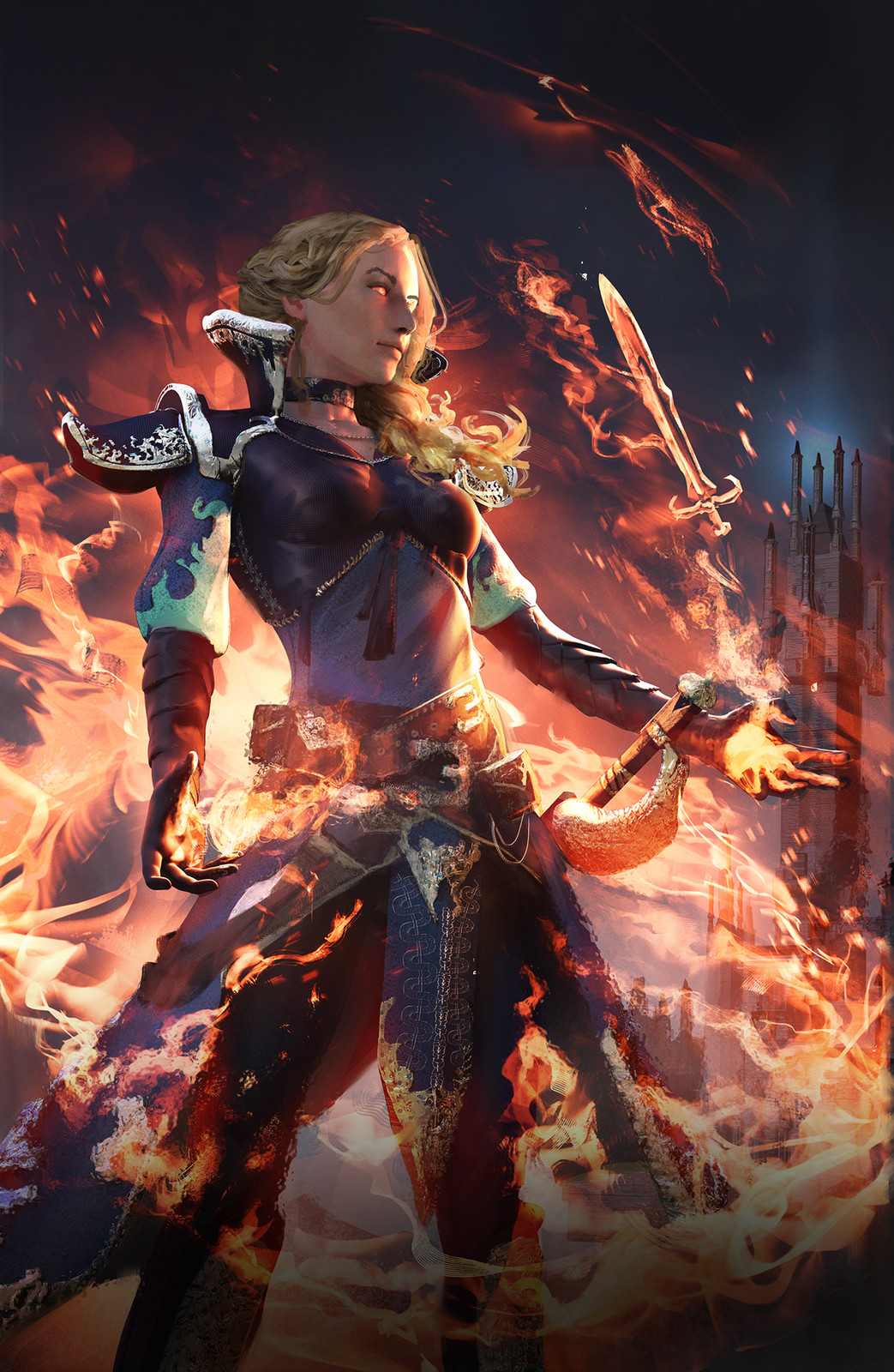
Artist Credits
Page 1: KABAM Card by Red Pencil Art
Page 3: The Risen Queen by Andrey Vasilchenko
Page 6: Dark Knight by Feng Guo
Page 8: Blood Knight by Erik Eng
Page 9: Crow Knight by Rotaken
Page 11: Geyadrone Dihada by Aleksi Briclot
Page 12: Bone Cavalier by Fyreant
Page 14: Water Knight by Jason Nguyen
Page 15: Ascalonian Ghosts by Kekai Kotaki
Page 16: Summoning Bone Guys by ForrestImel
Page 18: Saints vs. Fallen II by Vasylina
Page 19: Assassin by Xu Zhang [Re-Colored]
Page 21: Mara by Allnamesinuse [Re-Colored]
Page 22: Assassin by Mario Teodosio
Page 24: Muscular Wizard by Phan Tuan Dat
Page 25: Final Judgment by Nino Is.
Page 27: Stygian Hunter by Nino Is.
Page 28: The Silver Tower by Sebastian Horoszko